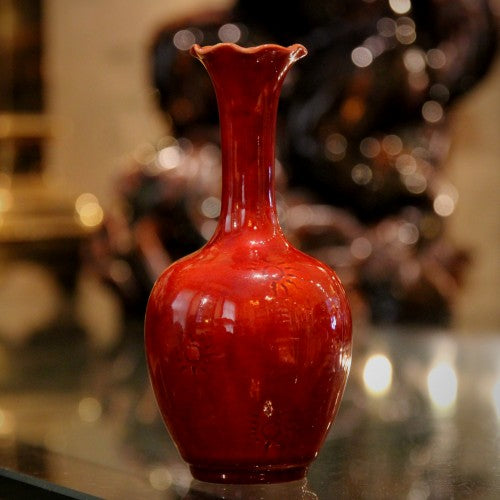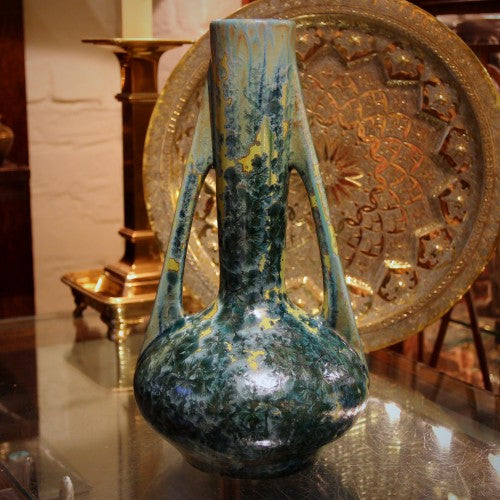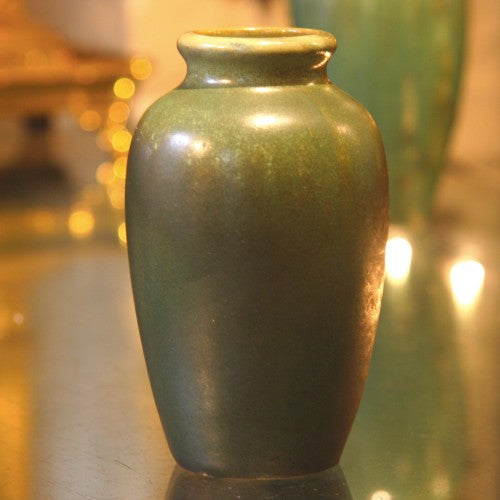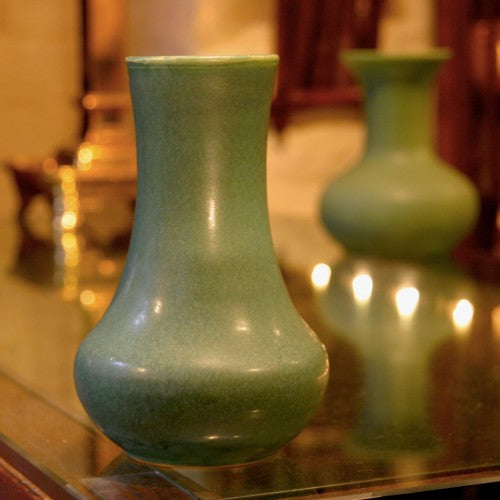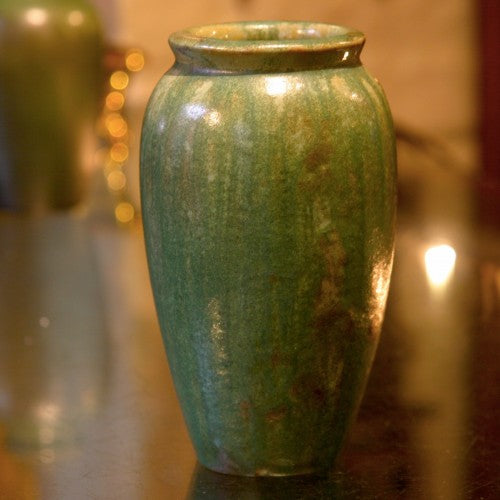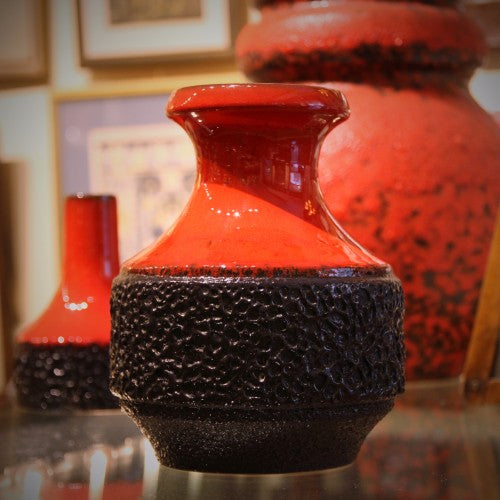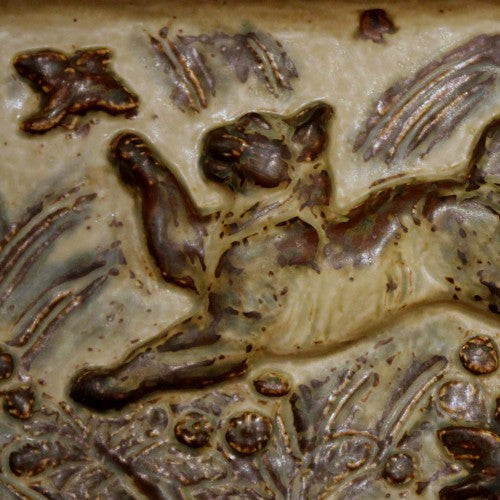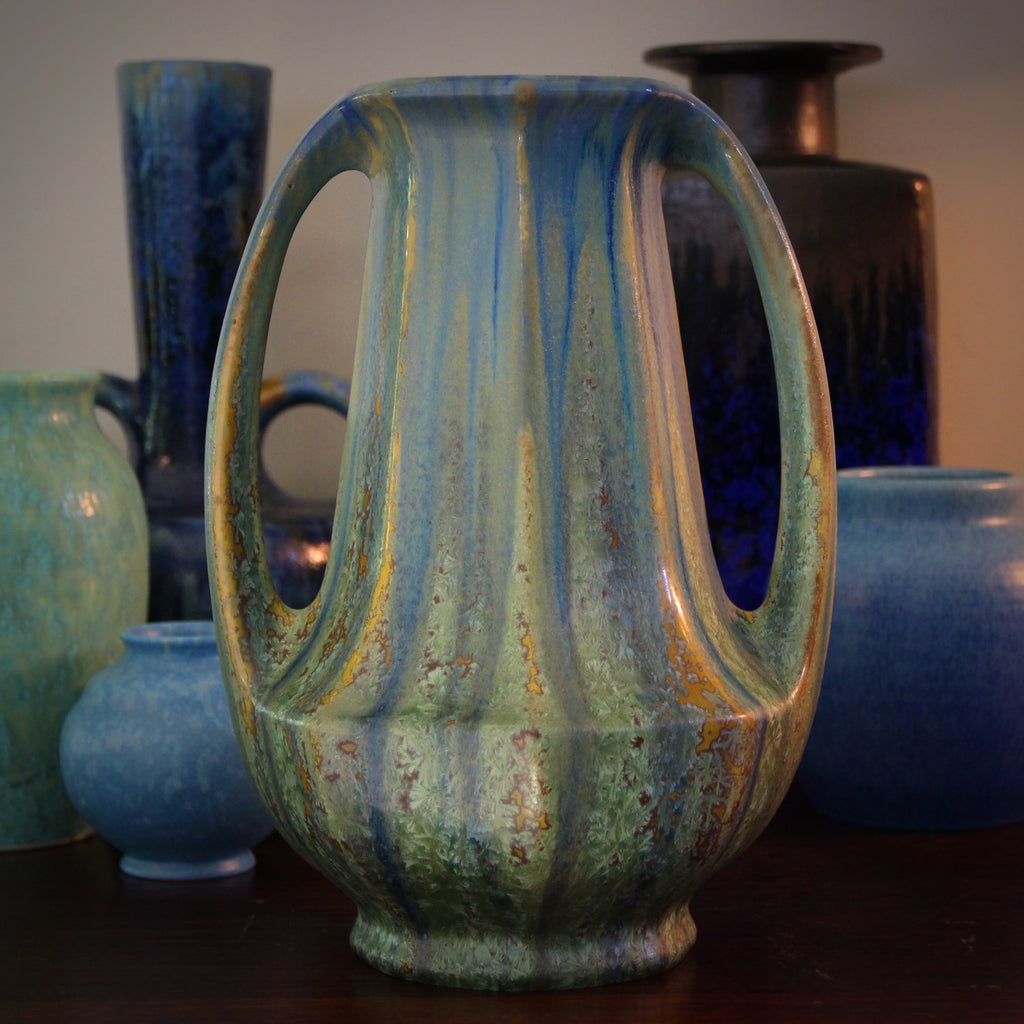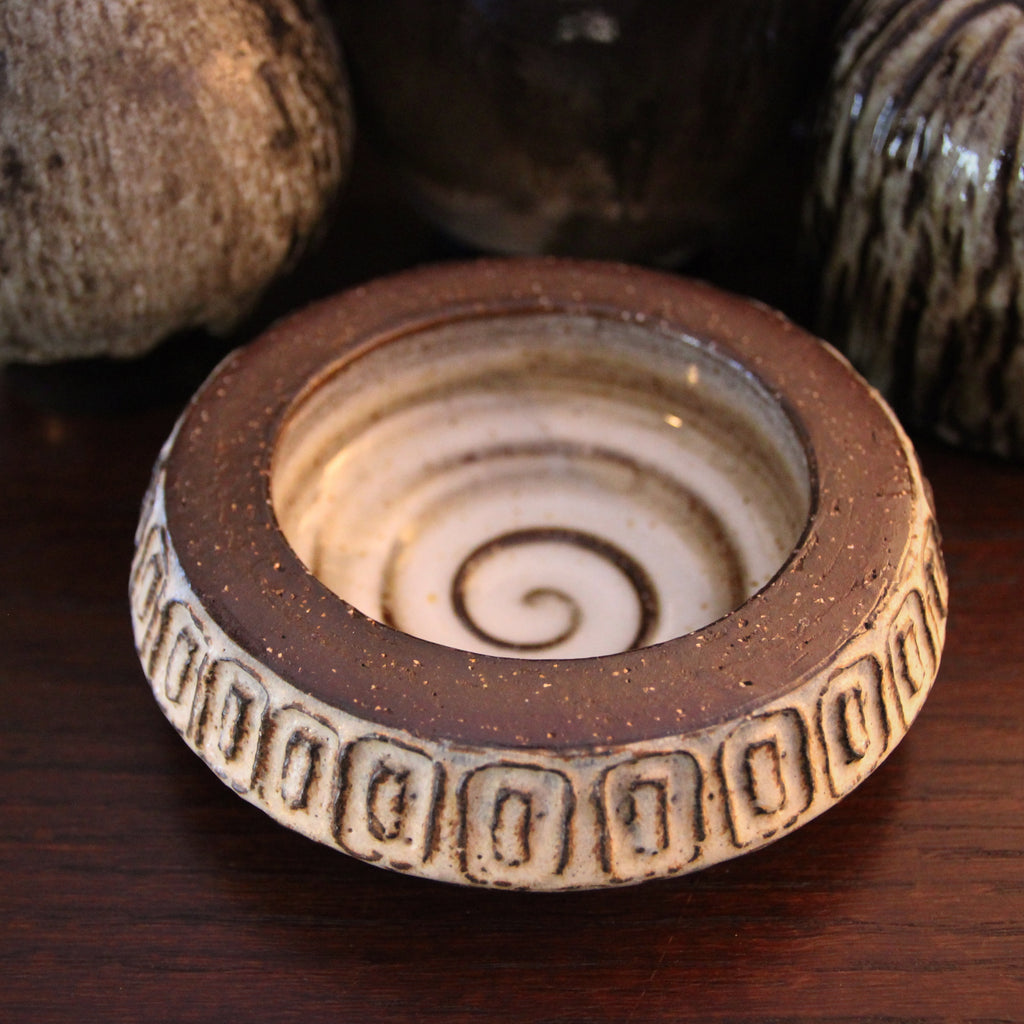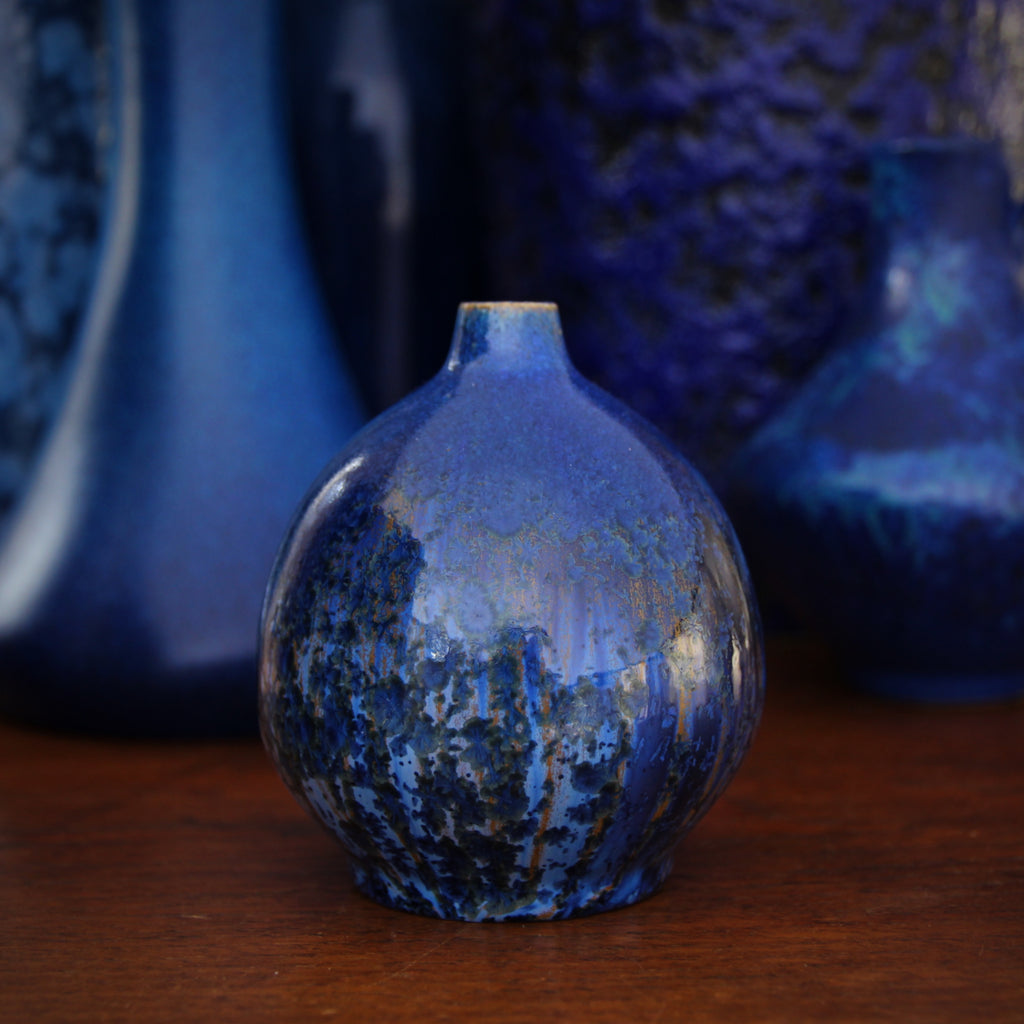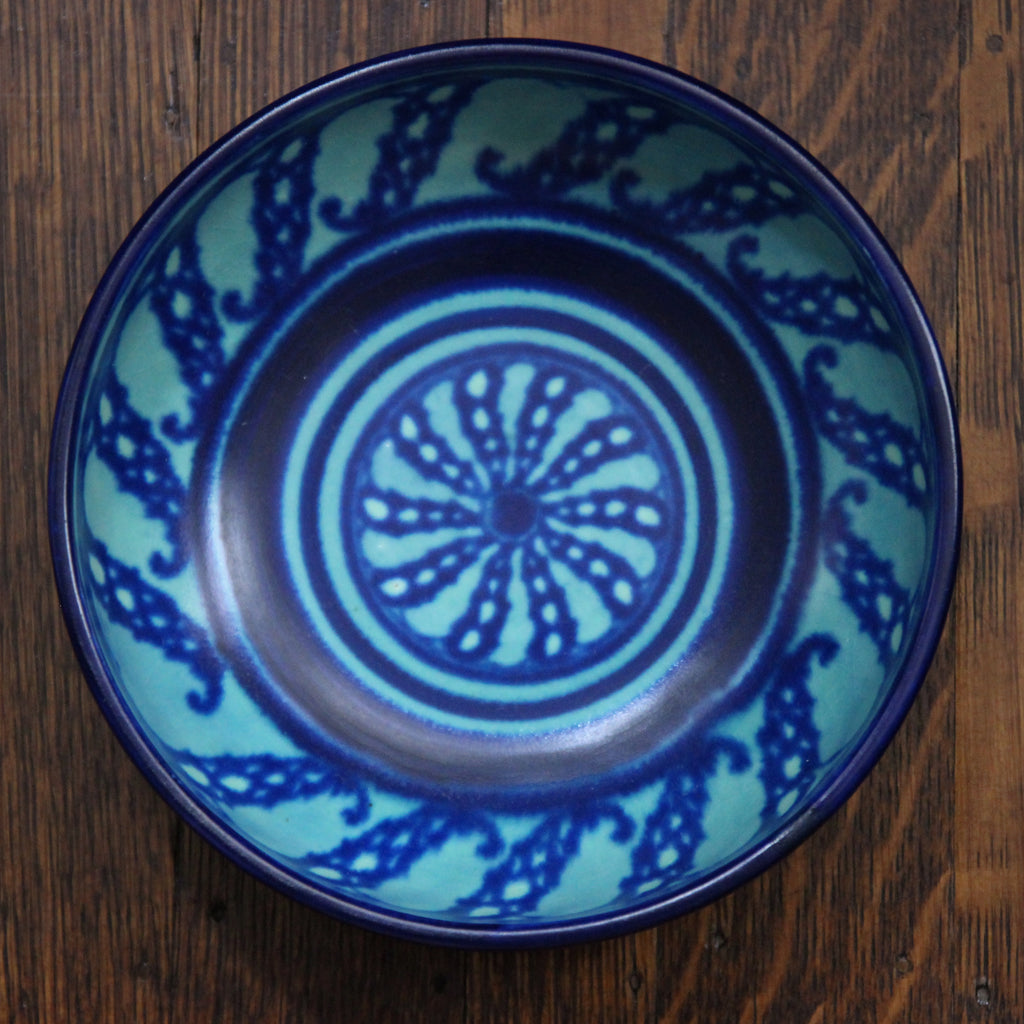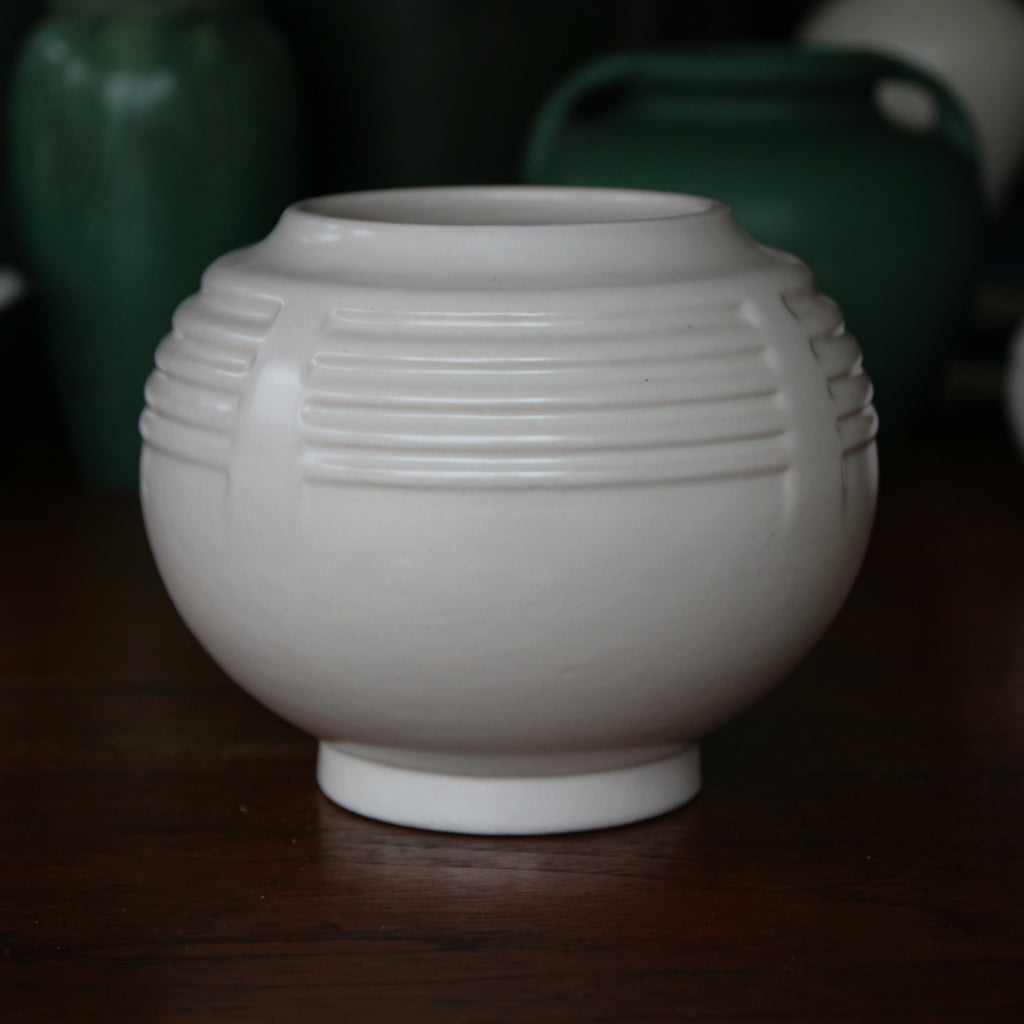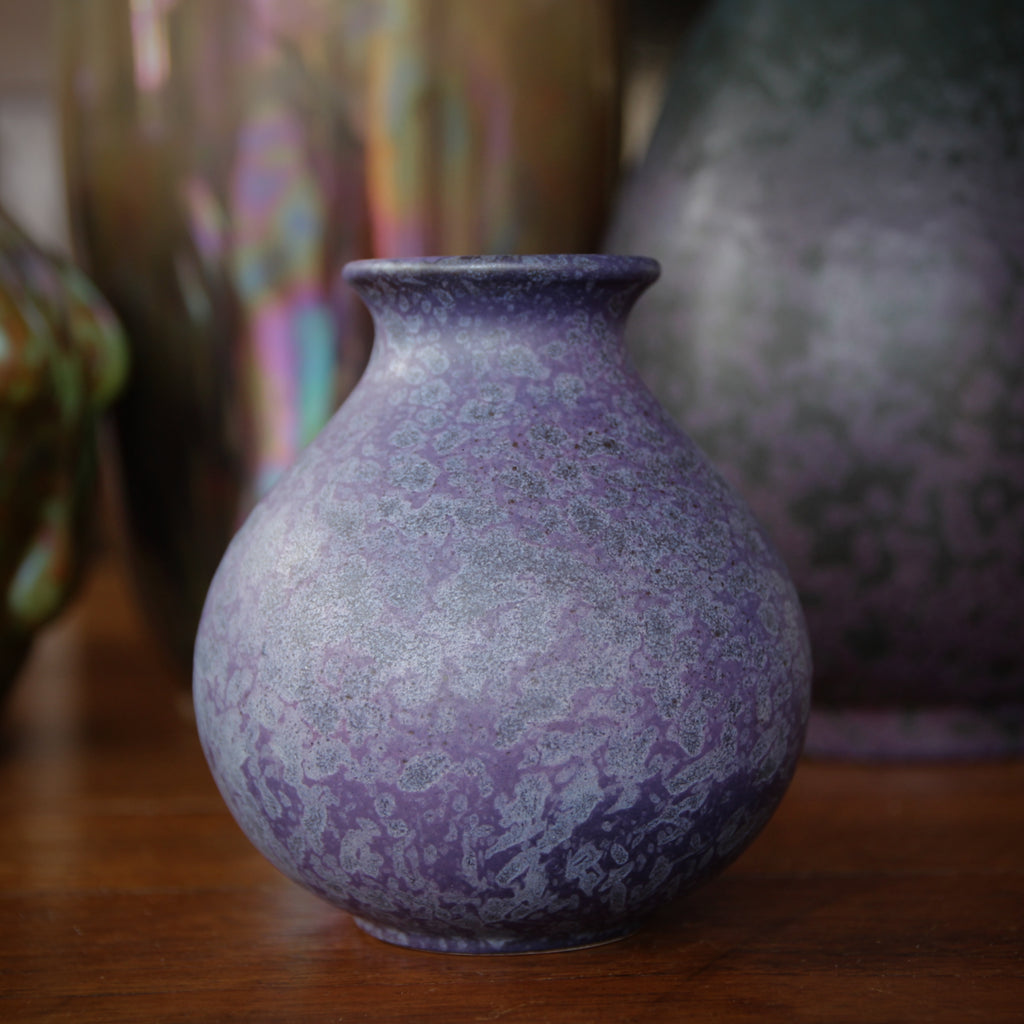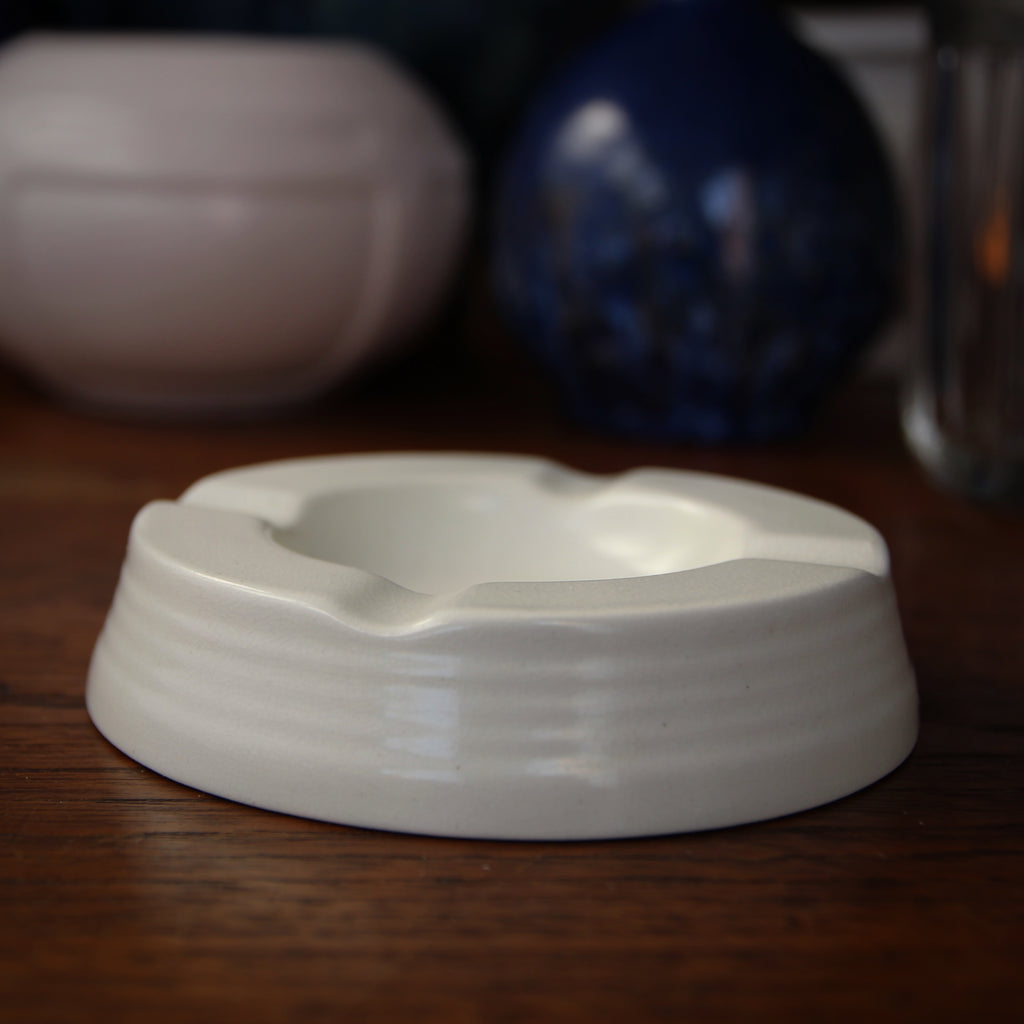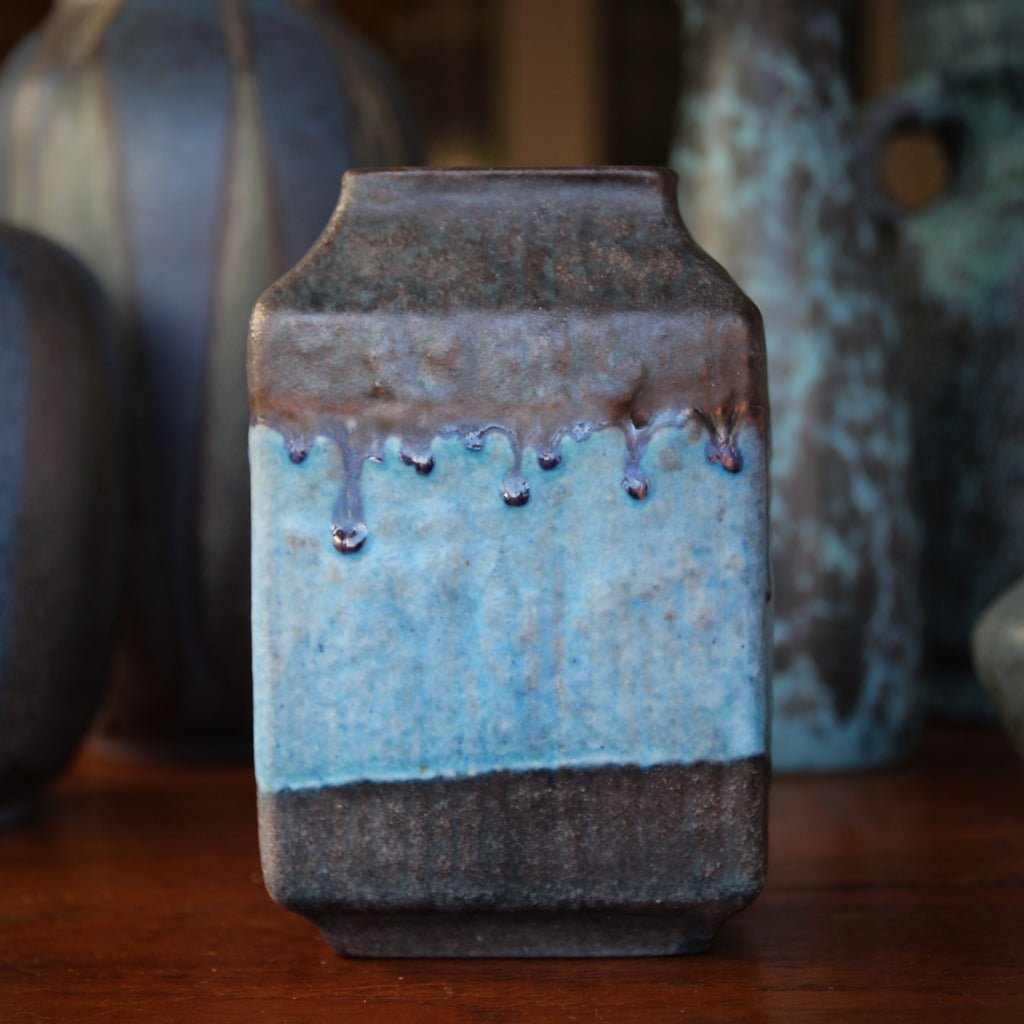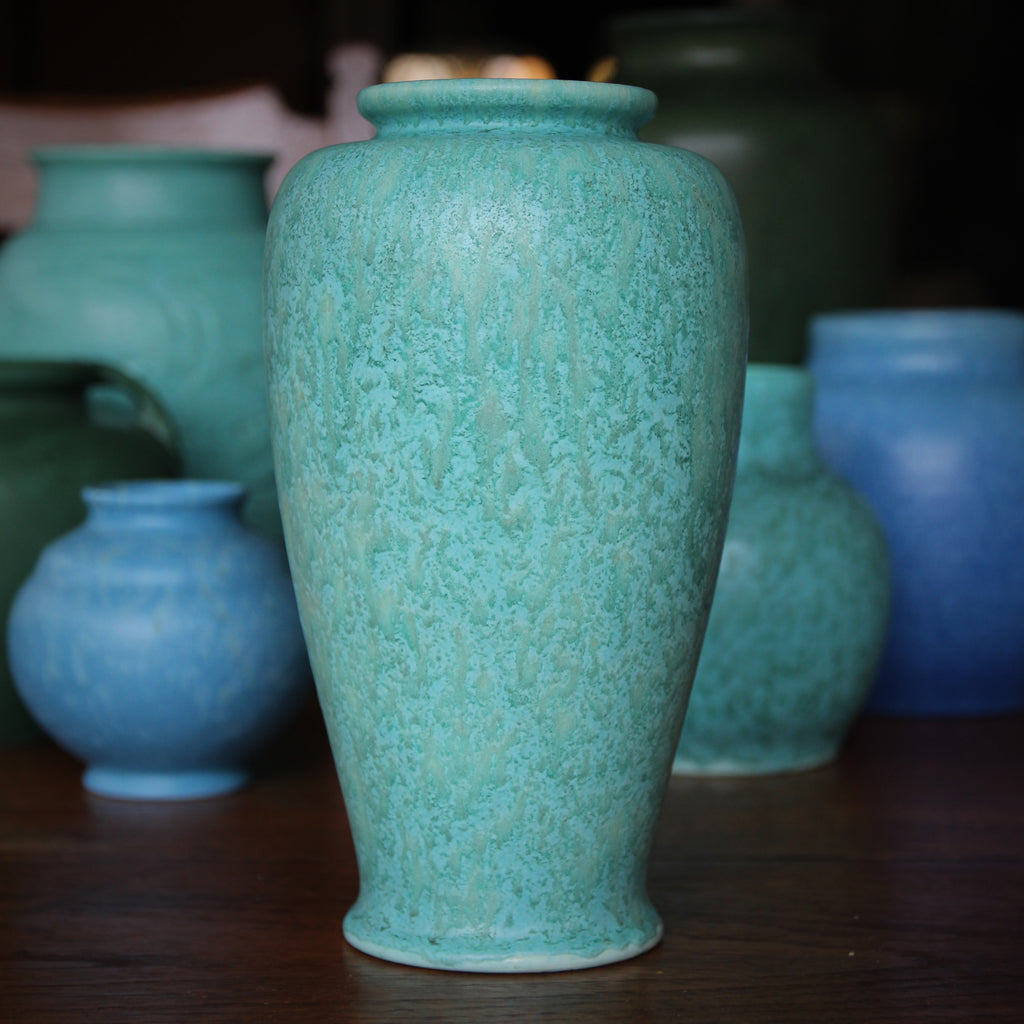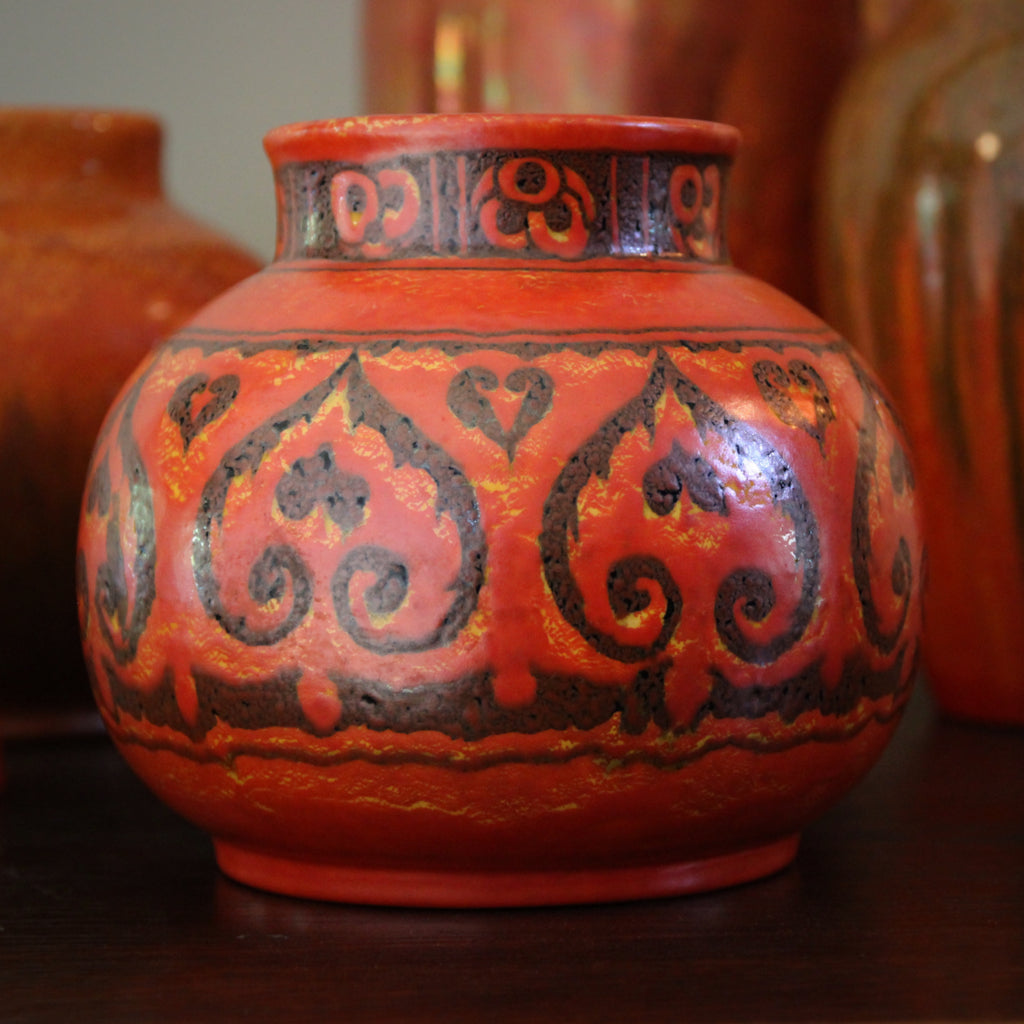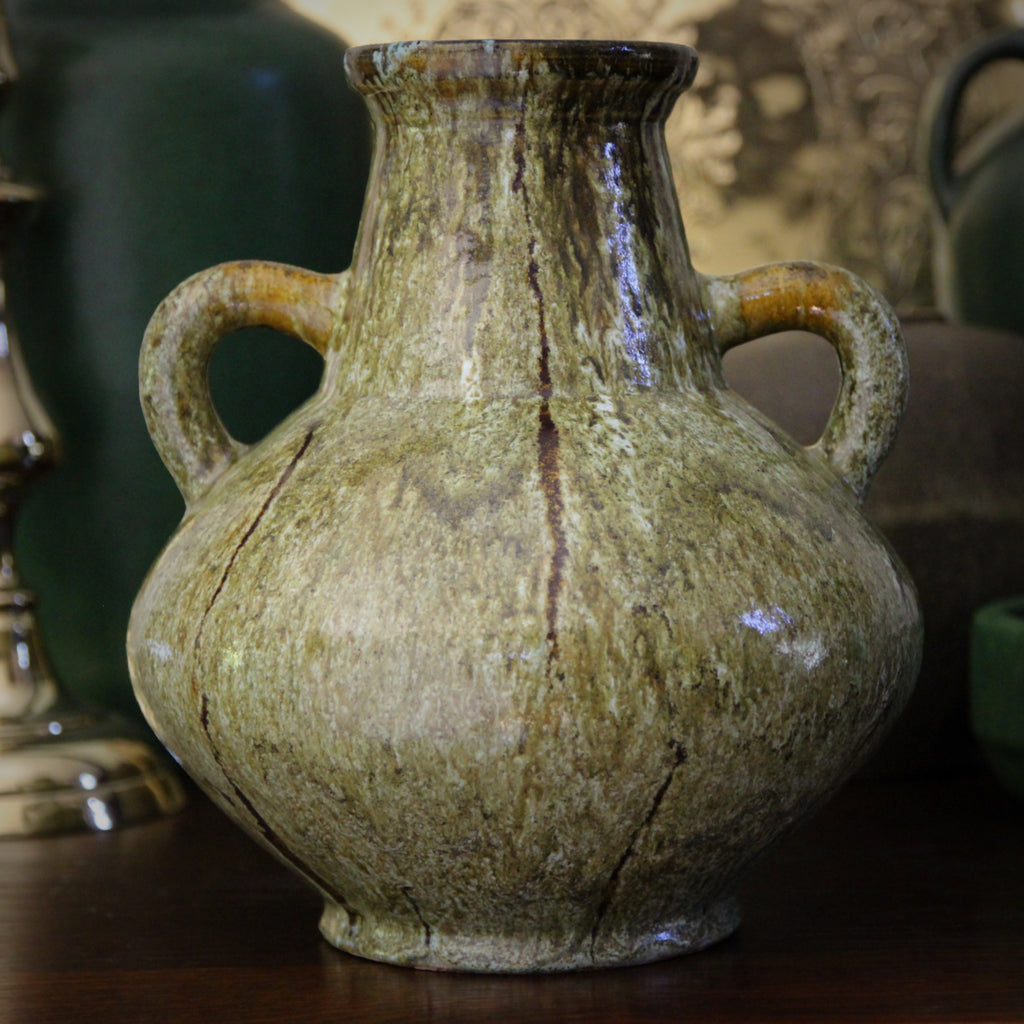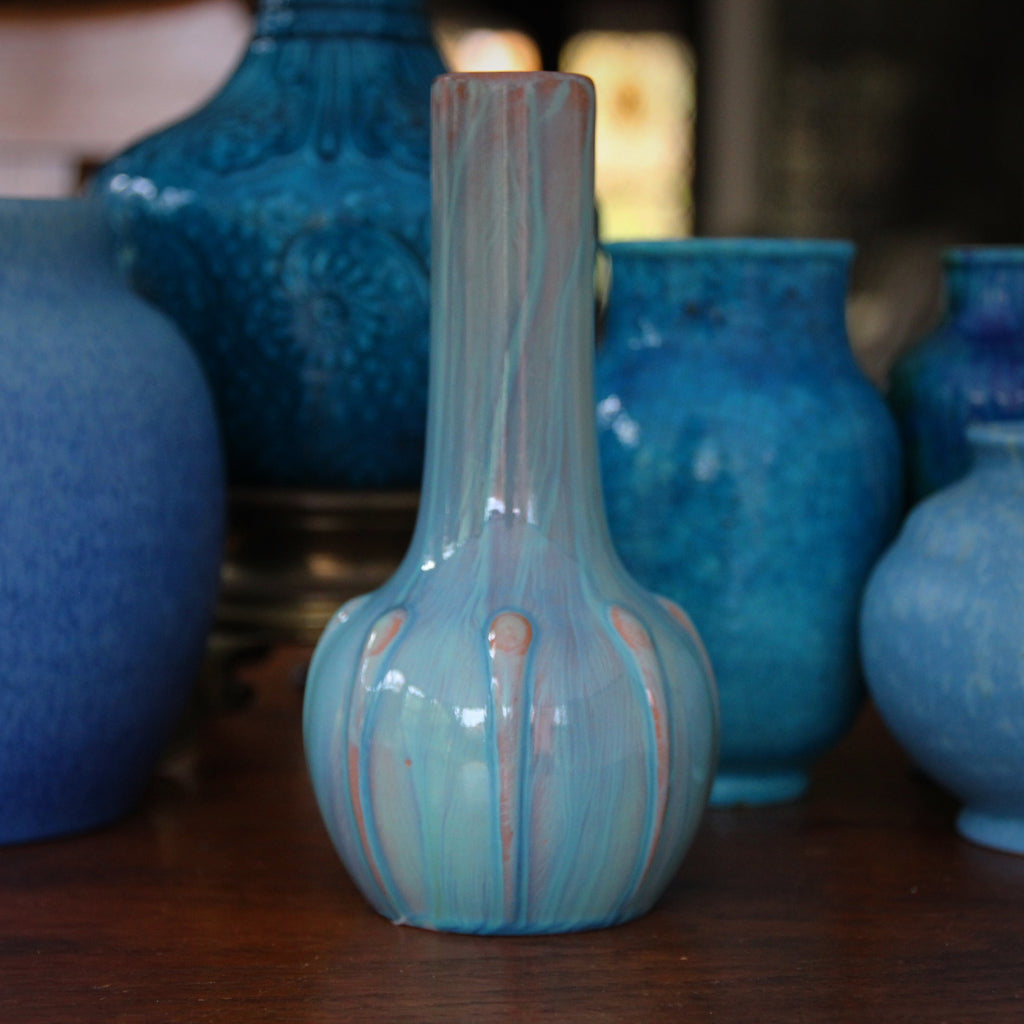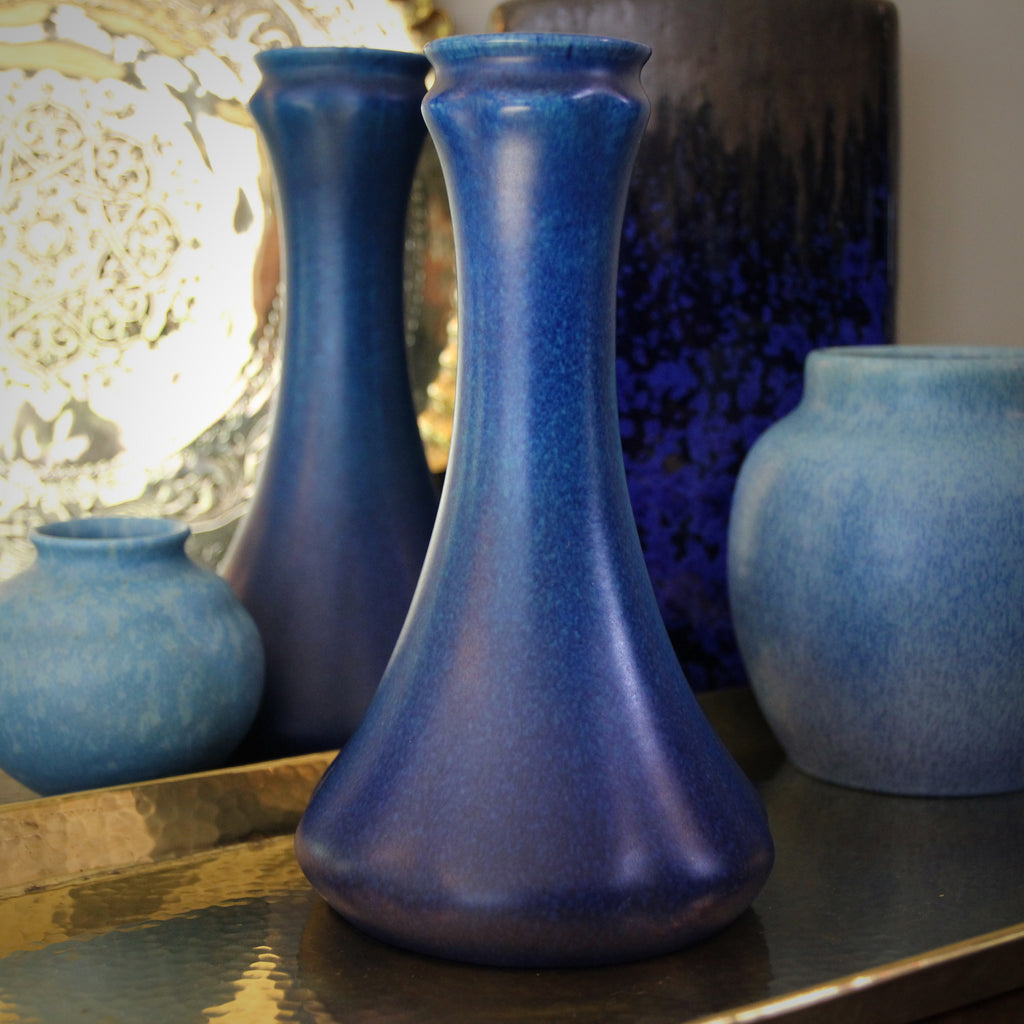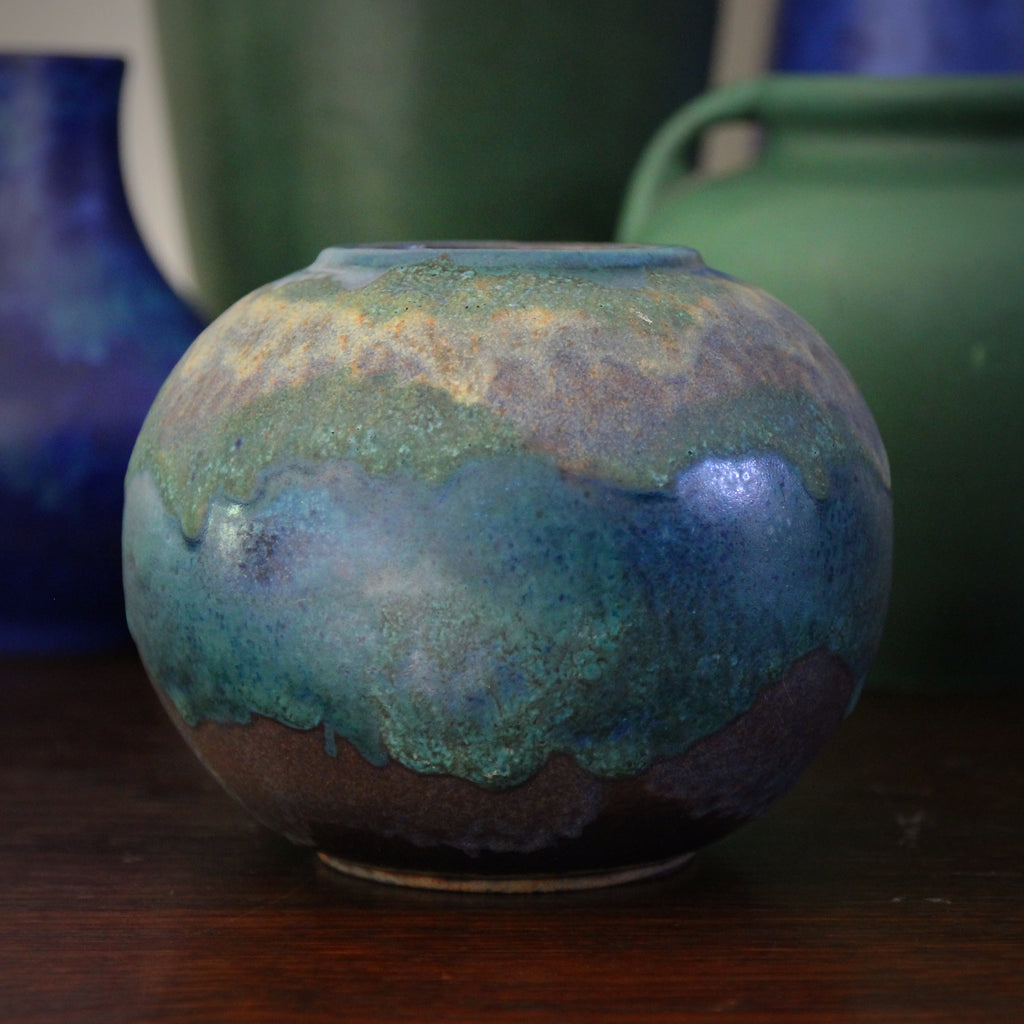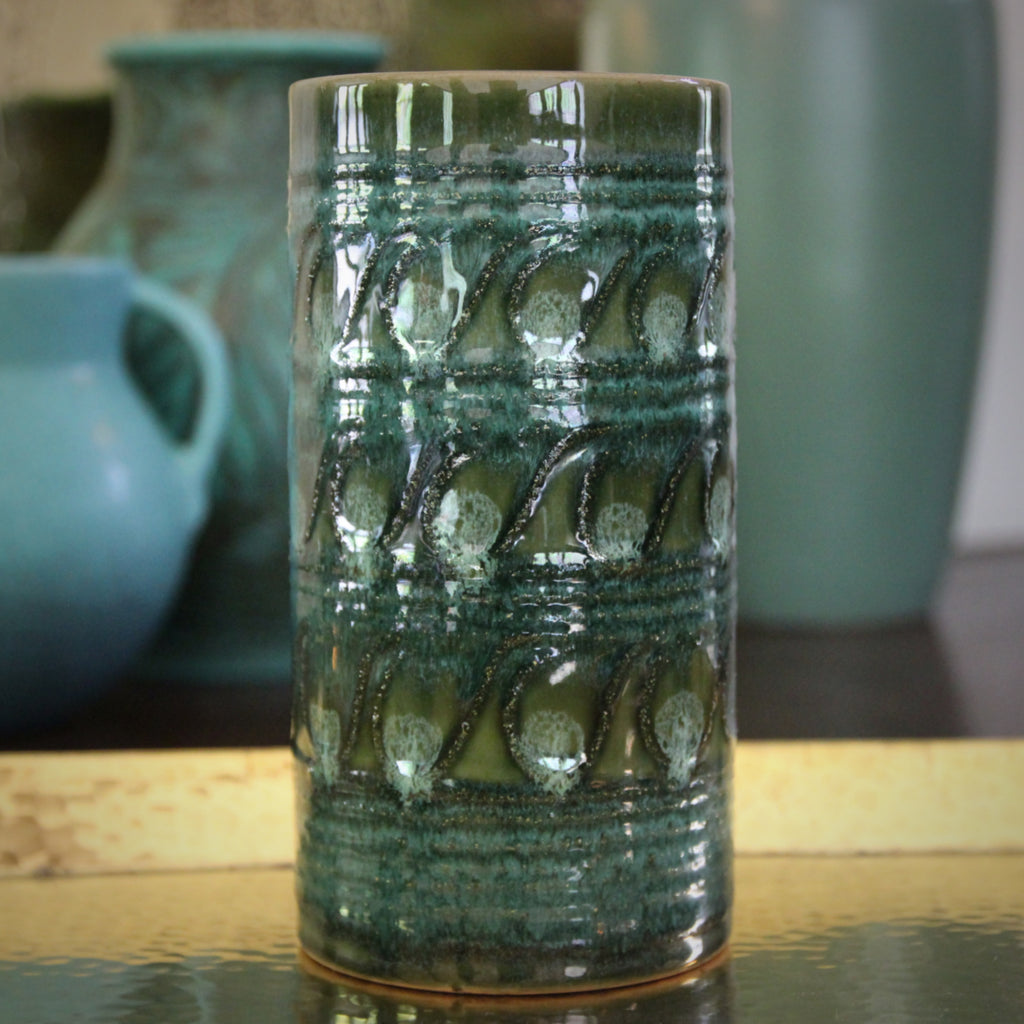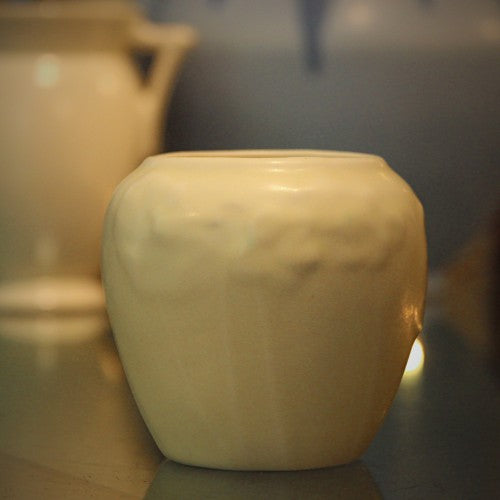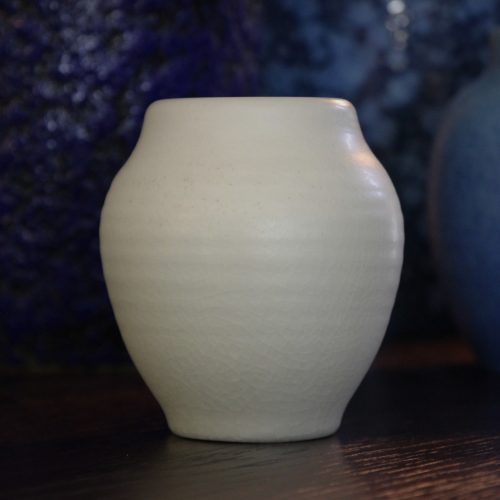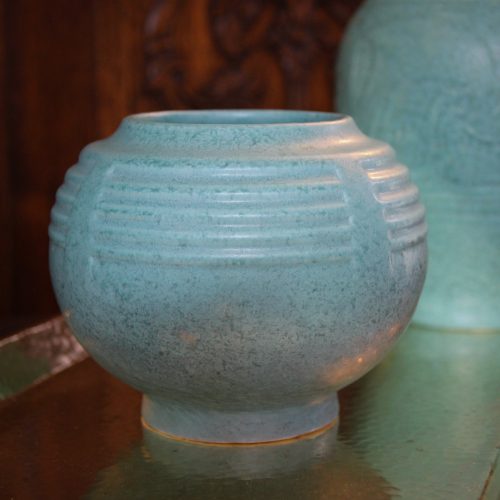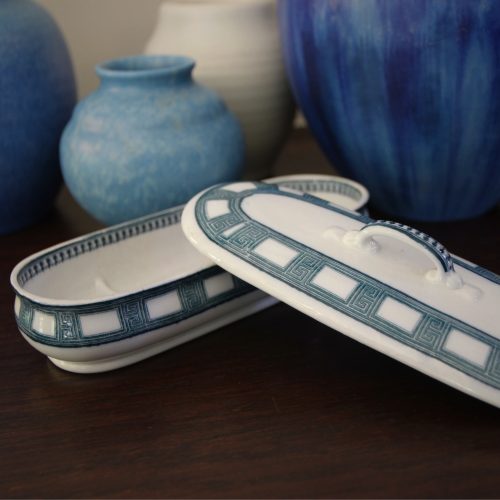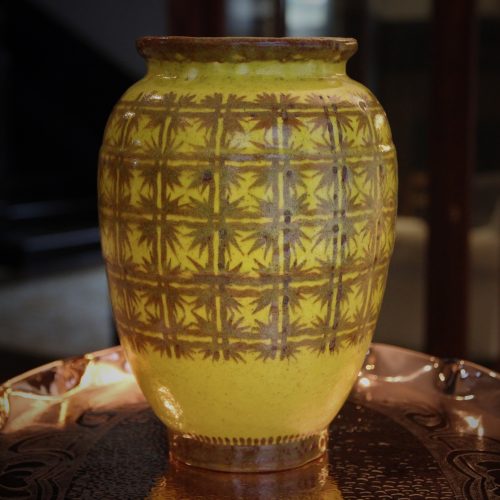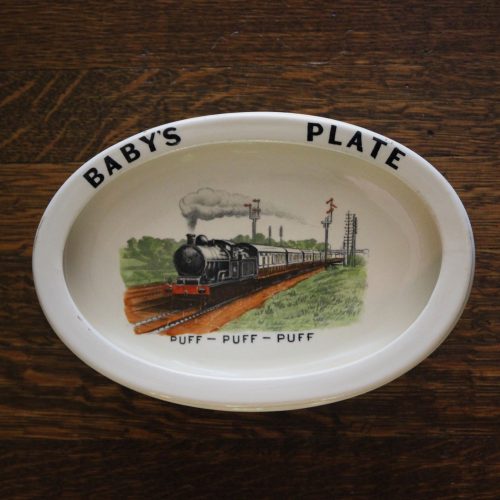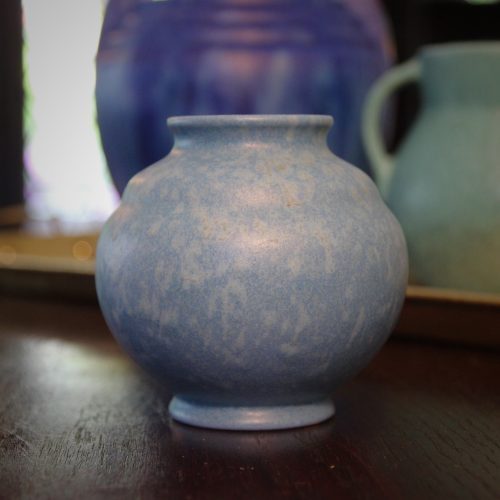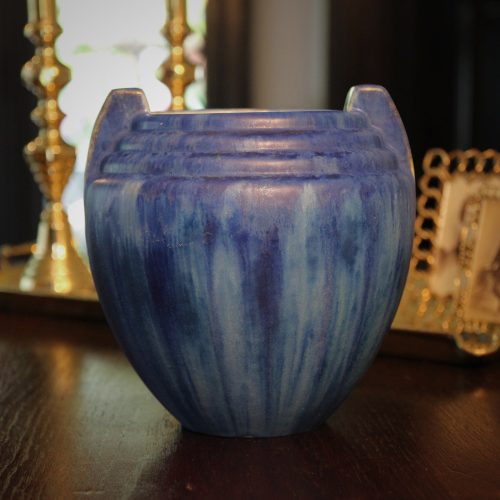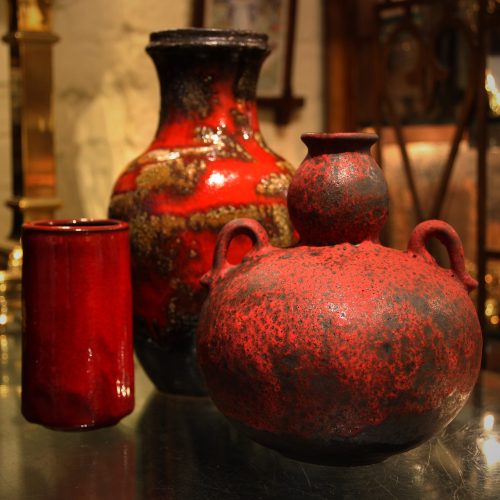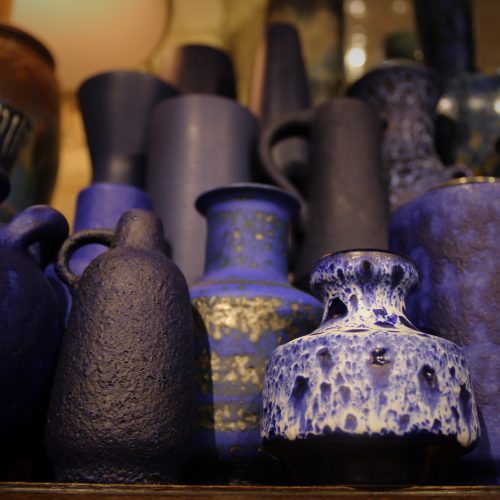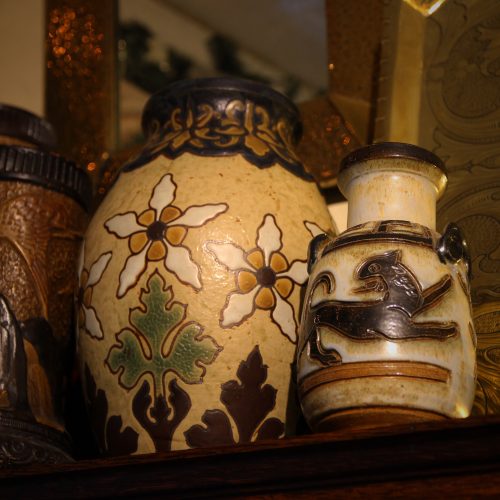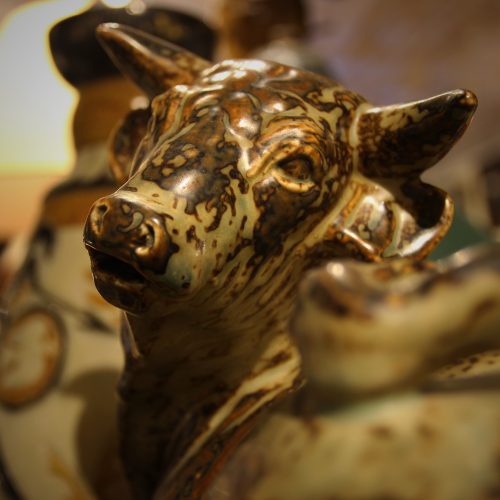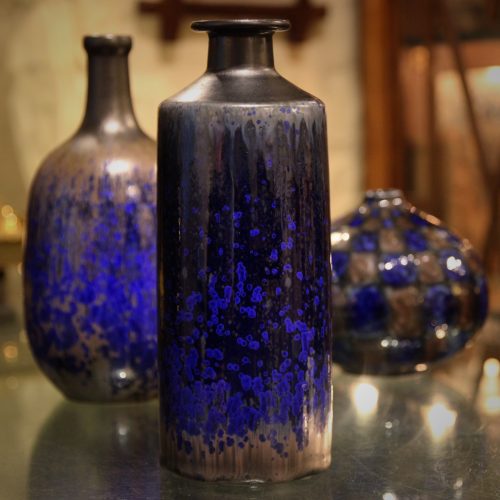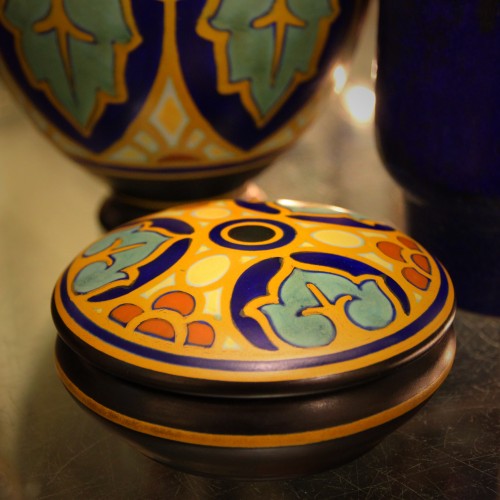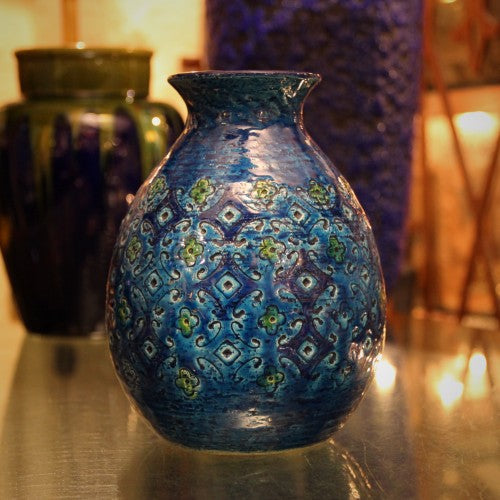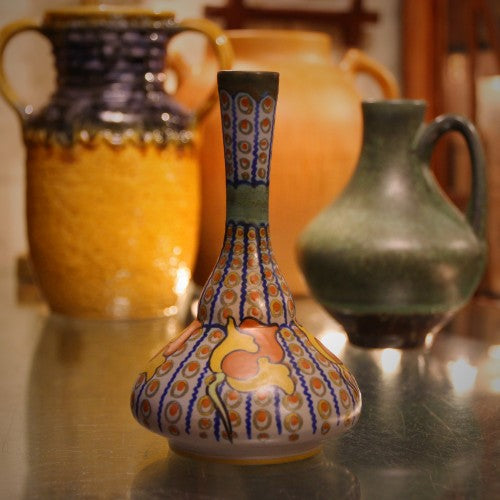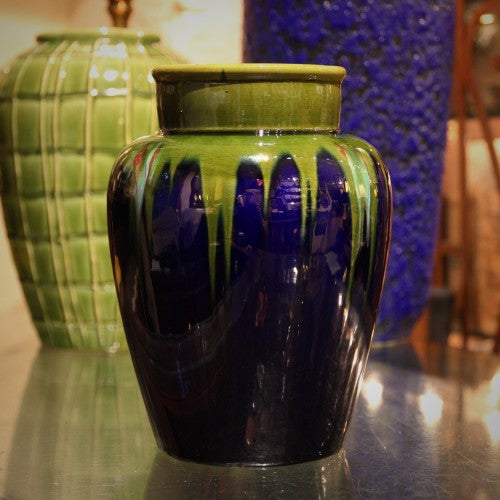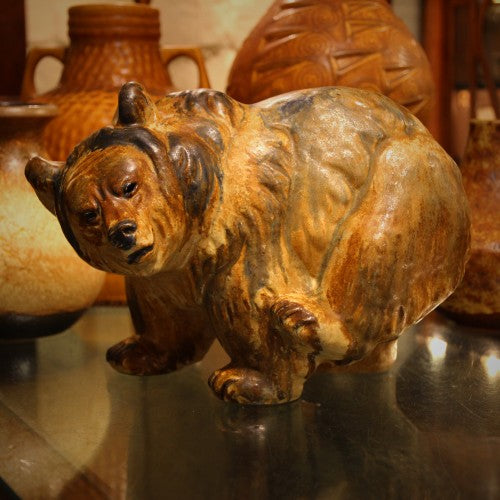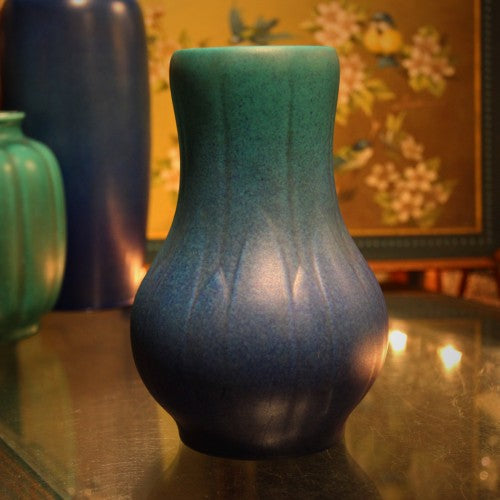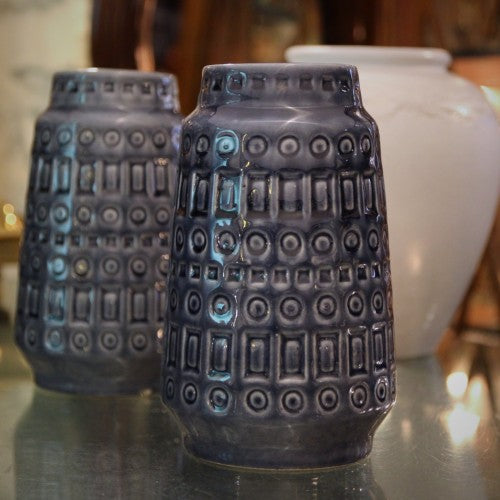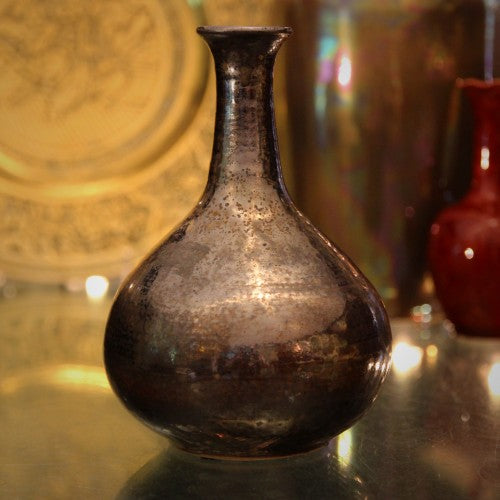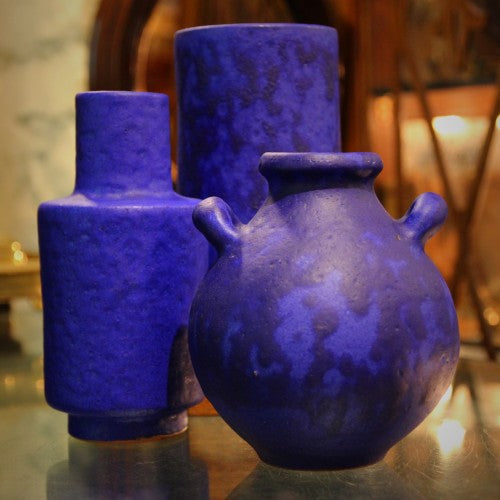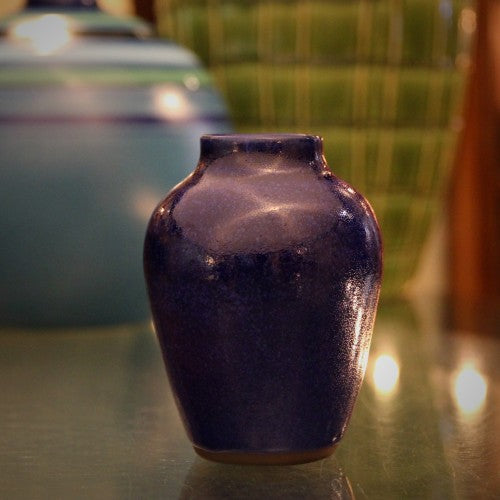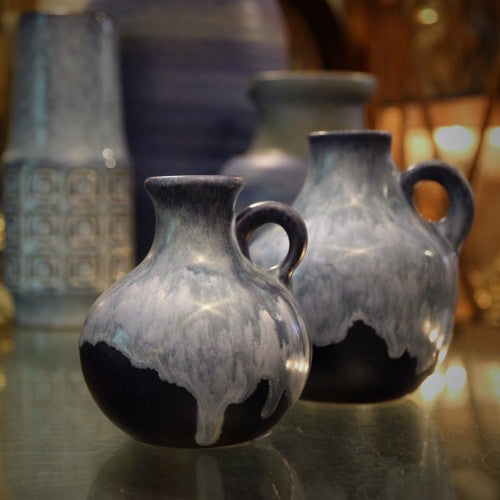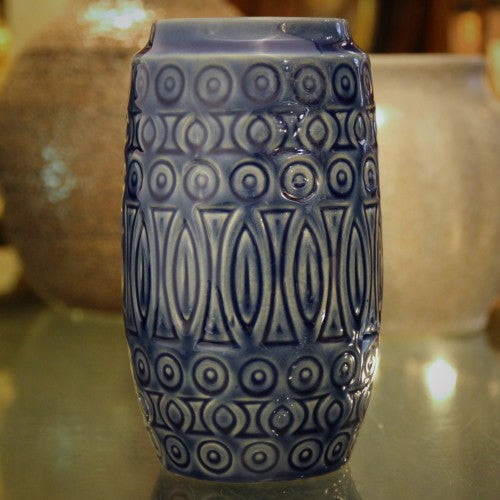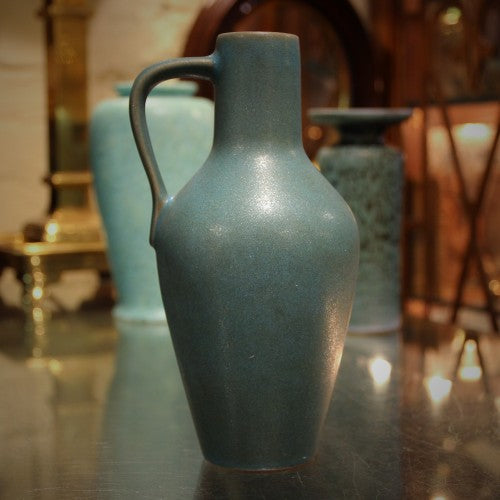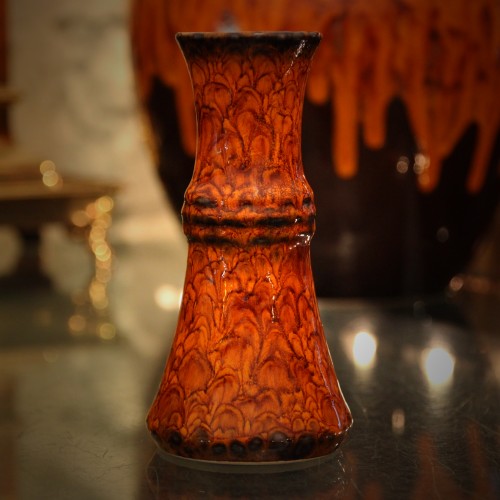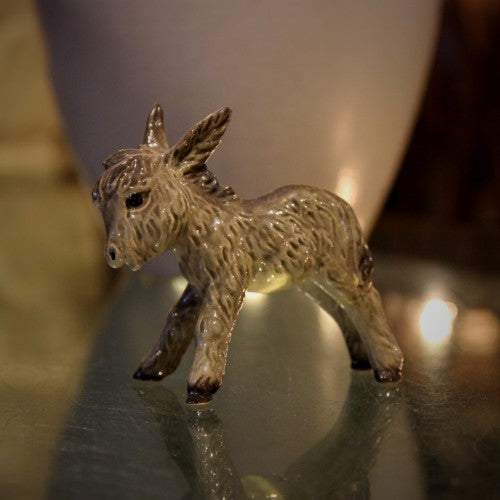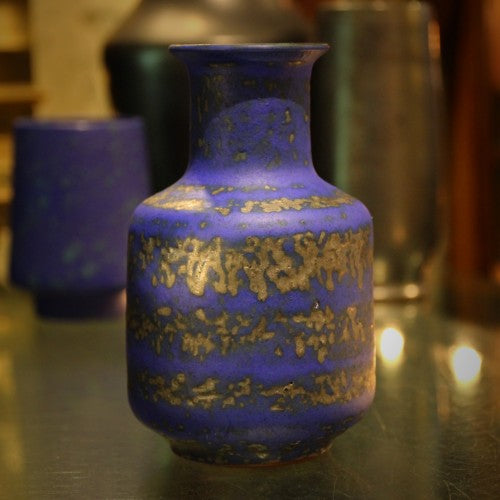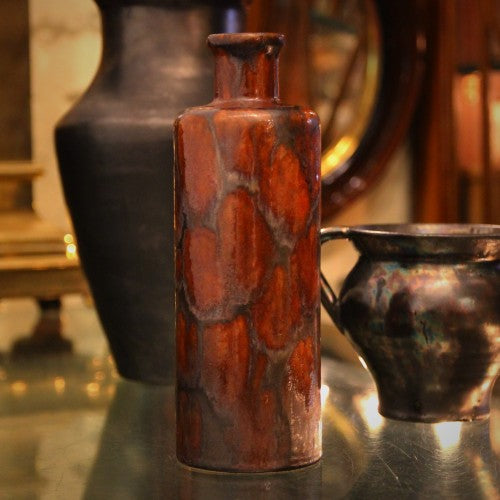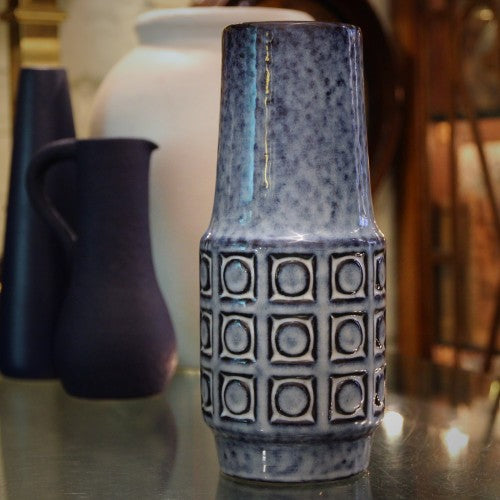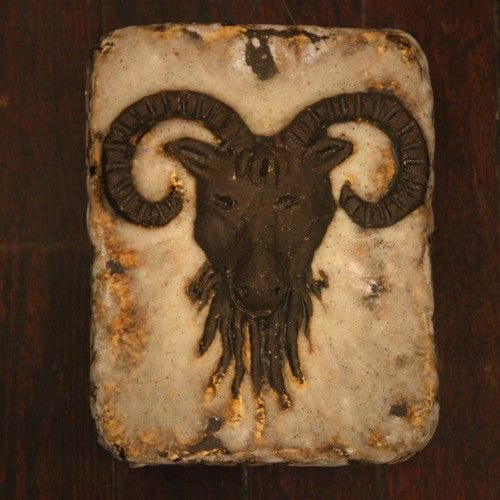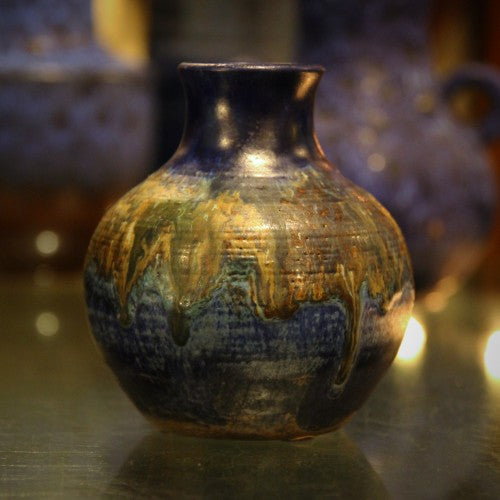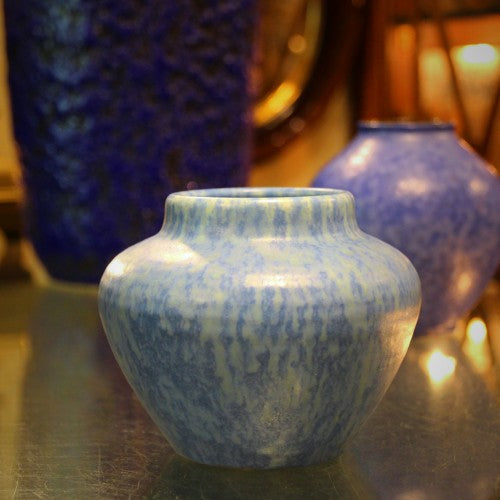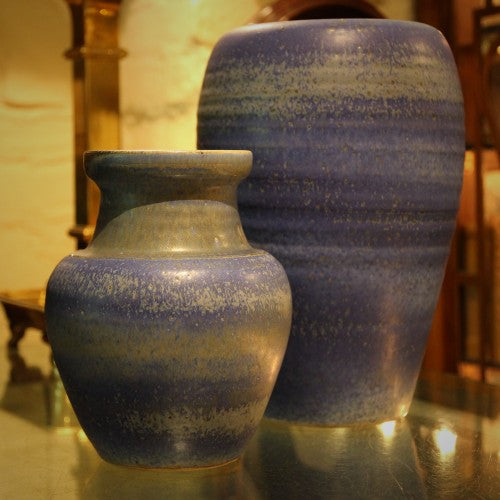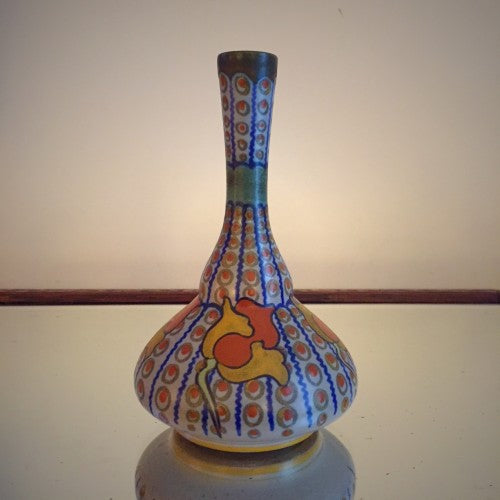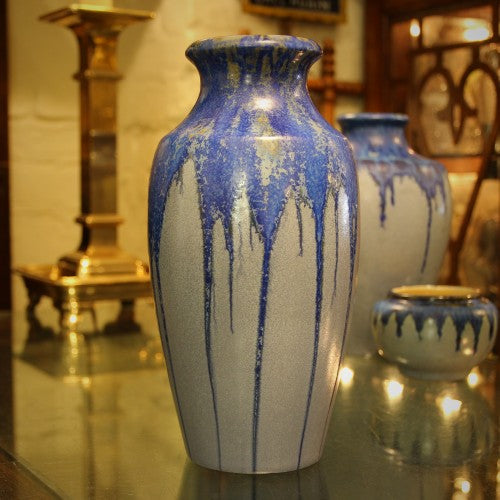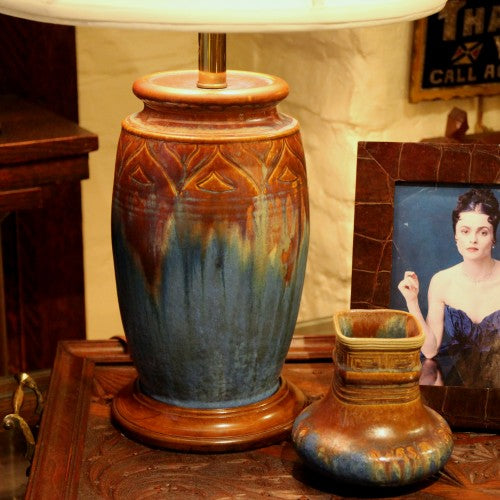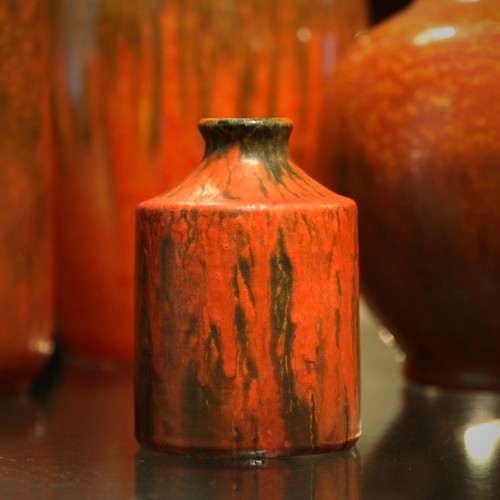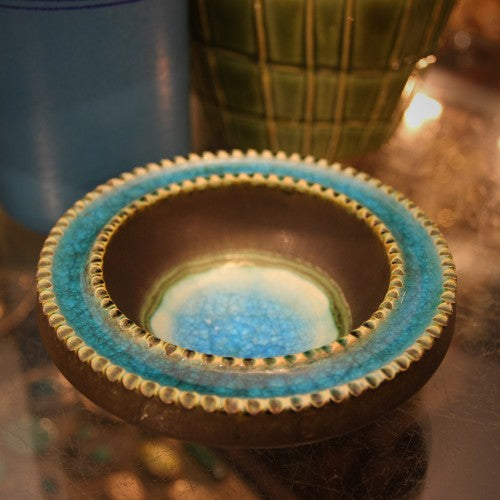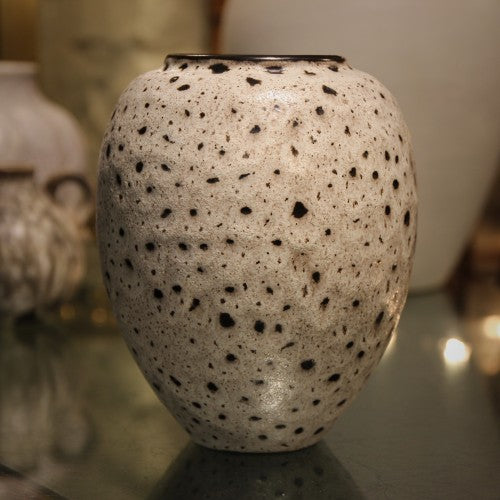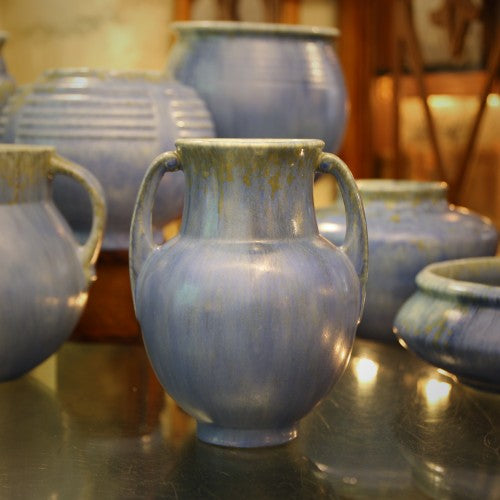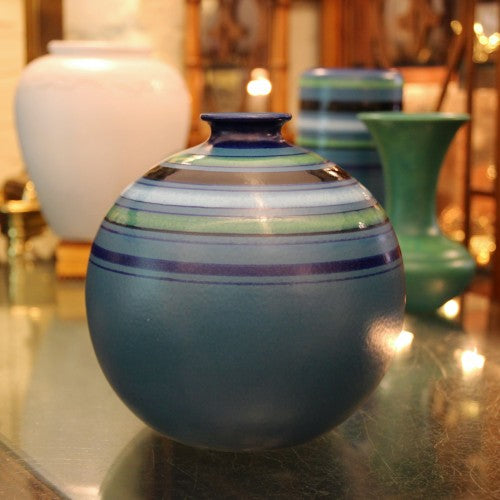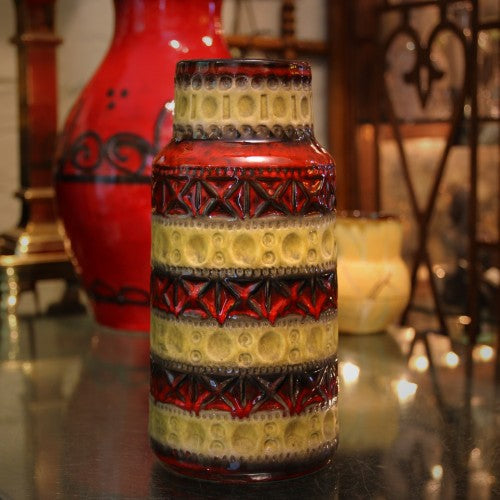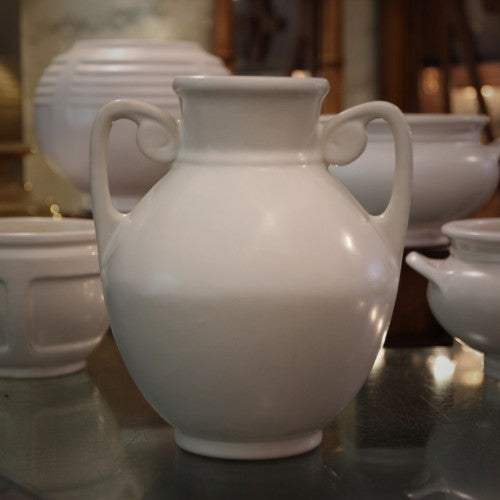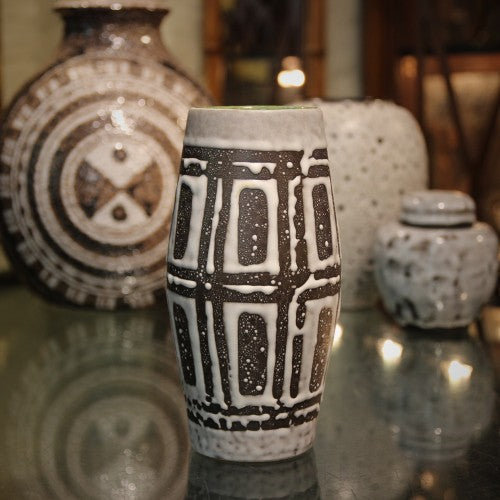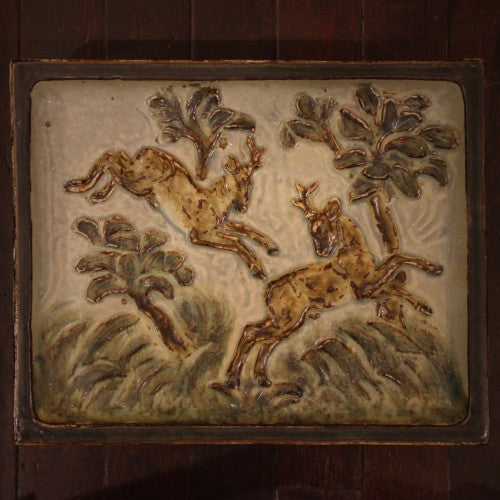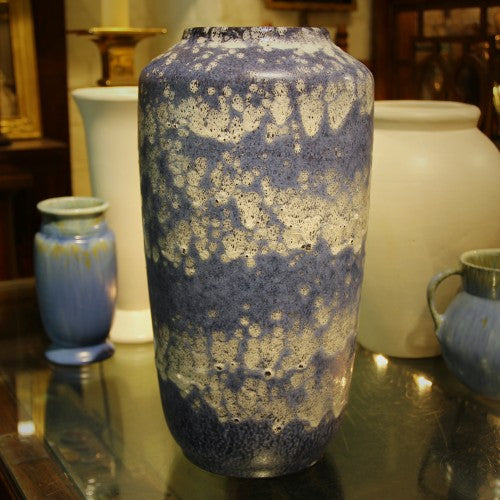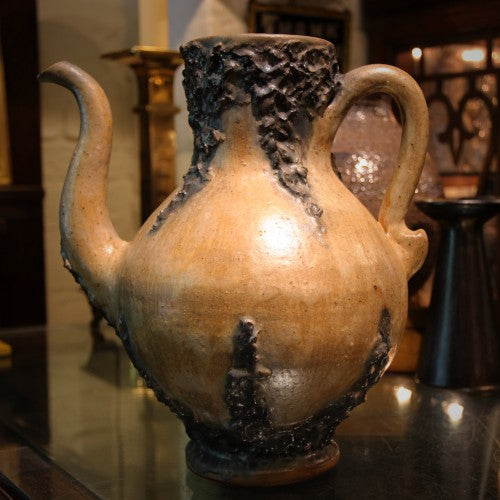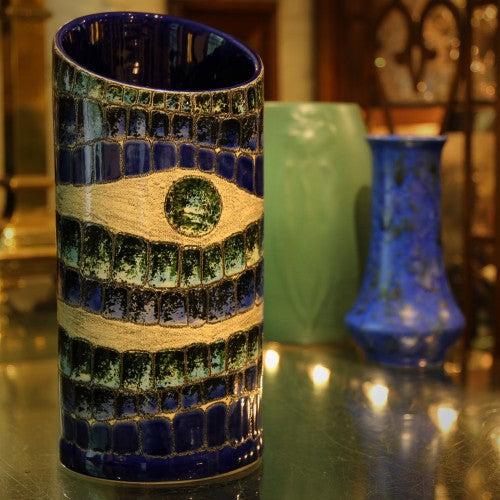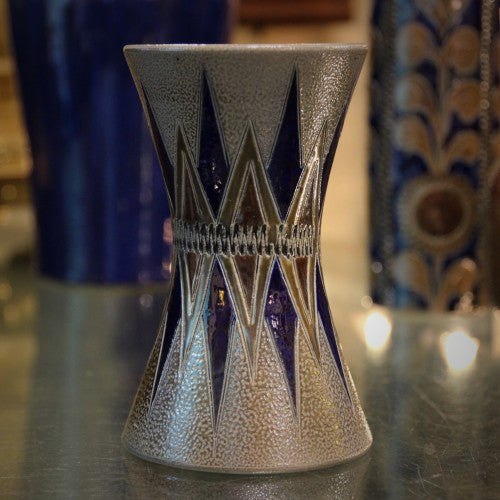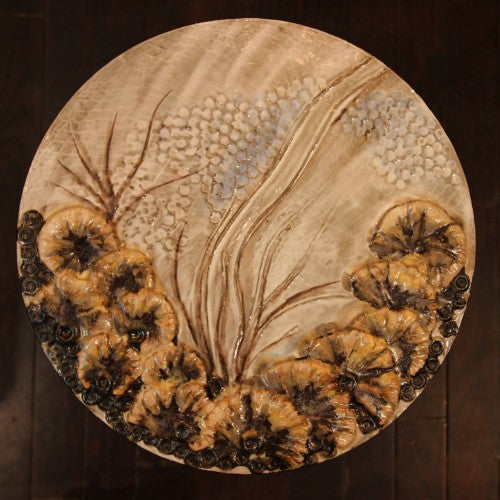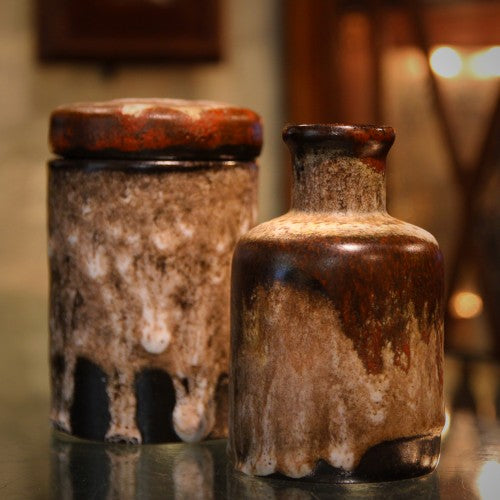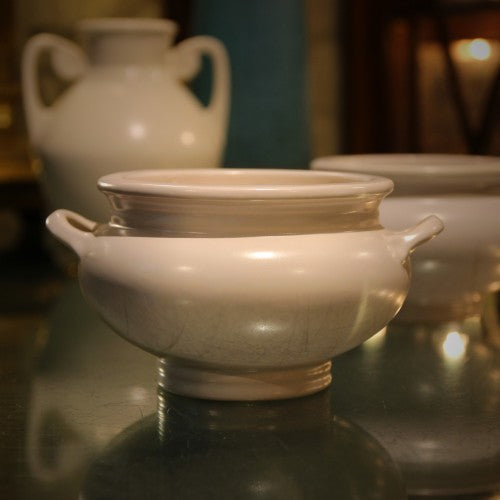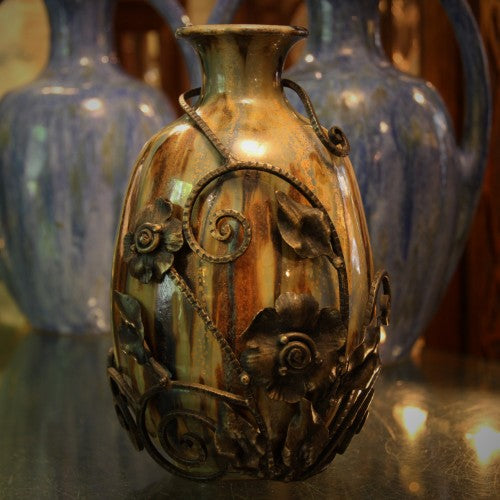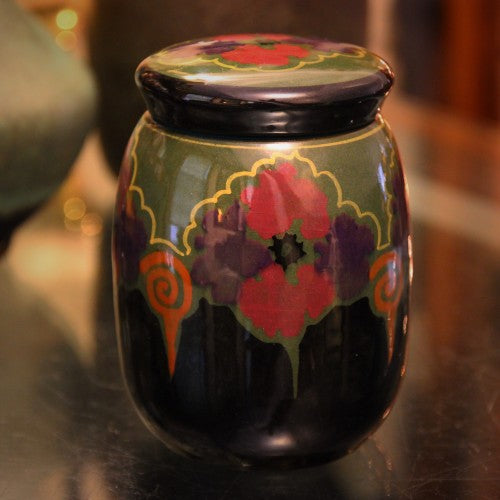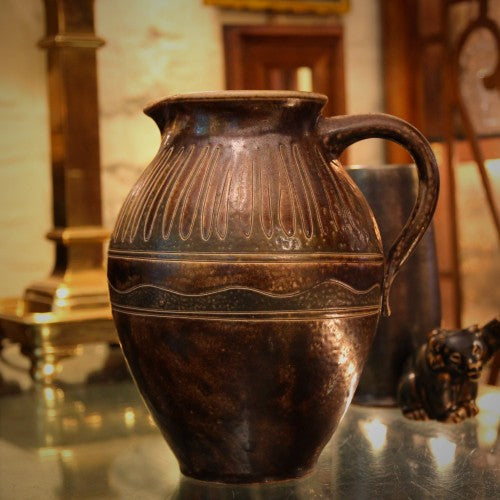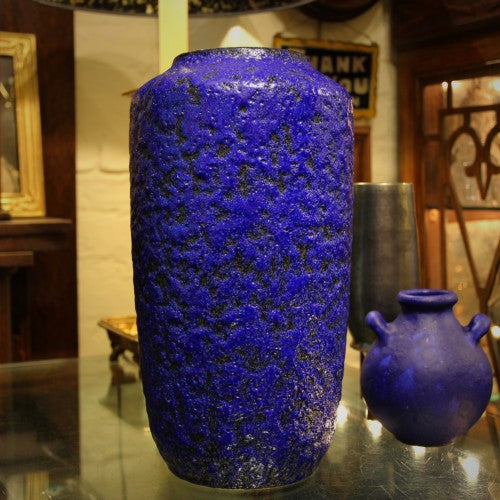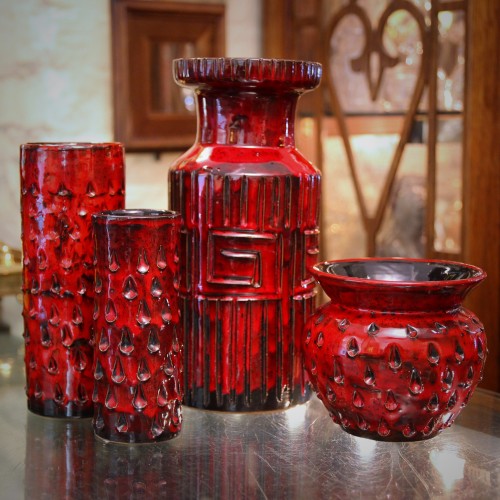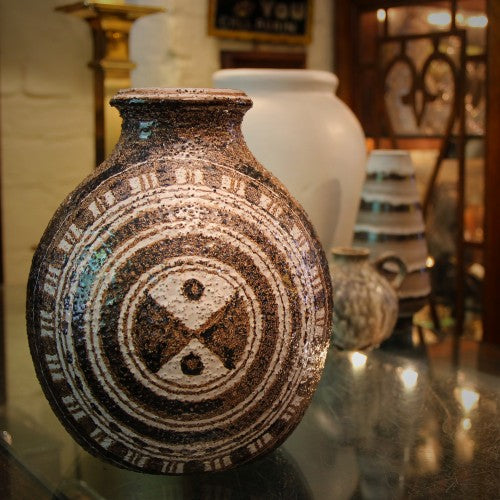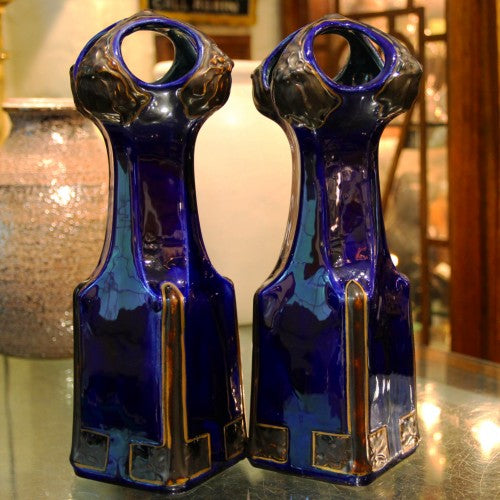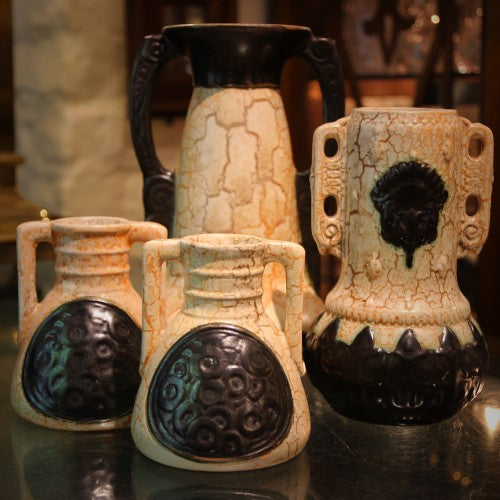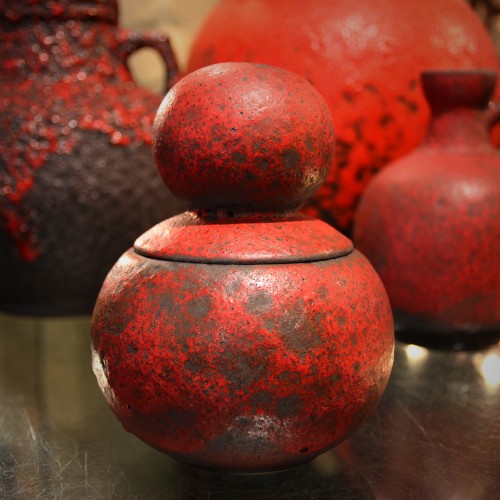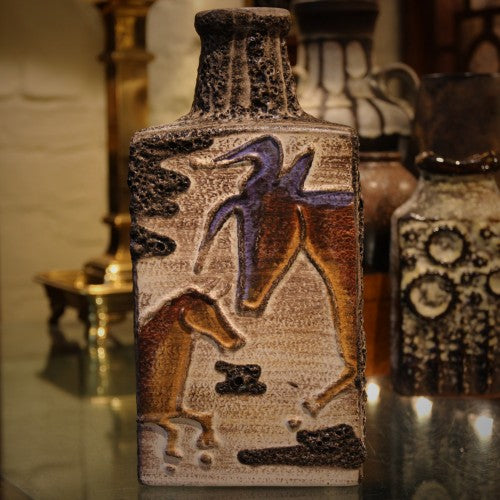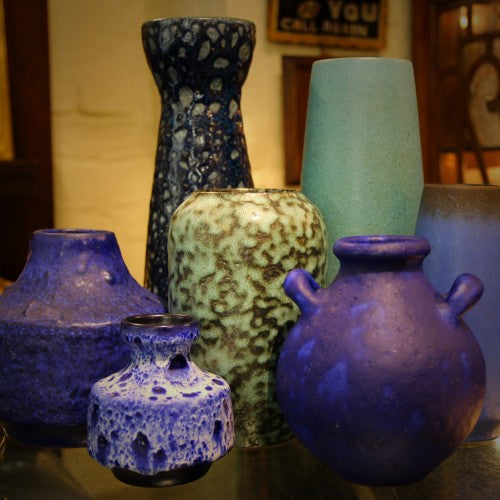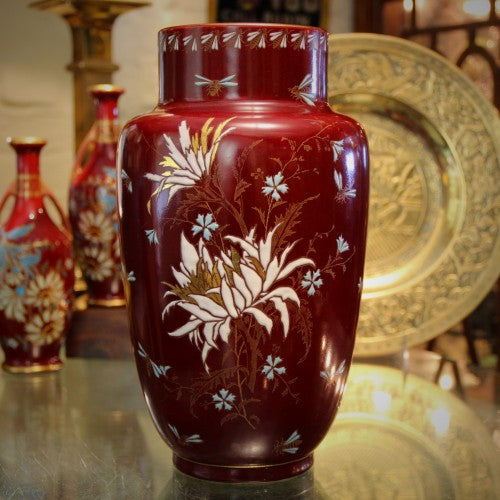JOURNAL — Art Pottery RSS
A Satyress is the female version of the Satyr—in this case, a human woman, usually bare-breasted, with the legs of a goat. While male Satyrs are commonplace in art, architecture and design, female Satyresses are not. Because the male creatures are usually associated with drunkeness, mischief and raw, animalistic sexuality, perhaps Classical and Rennaisance artists avoided […]
Burmantofts Pottery
Just received, a Burmantofts “Chinese Red” classic “Oriental” vase, made in late-Victorian England. It captures beautifully the West’s fascination at the time with Eastern culture (Far-East and Middle-East) and Europe’s attempt to replicate the Oriental style in its own way. Burmantofts was a pottery manufacturer in Leeds, England. It was established in 1859 when a […]
The 1910’s: Design Crystalizes
Through the ages, ceramics have played a very important part in human societies. Ceramic objects—ranging from the highly utilitarian to the purely decorative—are amongst the most plentiful finds in archaeological sites and tell us much about its long-gone inhabitants. And museums are full of shards from which the lifestyles of ancient civilizations are deduced. Even […]
Fulper Pottery – Part Three
In the year 1924, Mr. Stangl was promoted to company Vice President. Fulper Pottery, ever-expanding, built a second factory, also in Flemington, to produce its new line of “Fayence” tableware: plates, bowls, tea sets and other food service-related items. Sold as “open stock,” some of the dinnerware was solid-colored and some were hand-painted with Art […]
Fulper Pottery – Part Two
In the previous entry about the Fulper Pottery Company, it was 1910 and Johann Martin Stangl had just joined the firm. He created a line of highly-regarded Arts & Crafts pottery with complex, organic glazes. Mr. Stangl also developed a line of art pottery lamps, glazed in his trademark finishes—some of them topped with ceramic […]
Fulper Pottery – Part One
In previous days we told of our newly-acquired collection of art pottery. We continue our introduction of recently-received matte green pieces with the vase above, made by Fulper. In 1814, Samuel Hill founded Hill Pottery in Flemington, NJ, making water pipes, crocks, jars, and other “utilitarian ware.” When Mr. Hill died in 1858, one of […]
Contrasts in Color and Texture
A high-fired “Chinese Red” glaze sits above one of rusticated blackish-brown. Made by Jopeko in post-war West Germany, this piece perfectly captures the spirit of Mid-Century Modernism without being cold or sterile. It’s part of a recent collection of red Modernist art pottery now in-store. Please come into the shop to see the entire collection […]
Frisky Feline
Let's start the New Year with a jump: a frisky feline leaps—half-heartedly—toward his temptingly delicious prey on this Danish Modern stoneware plaque. Sculpted by artist Knud Kyhn for Royal Copenhagen, this oversized tile can be hung on the wall or permanently mounted with other tile work. Please click on the photo to learn more about it.
Auld Lang Syne
What a year! In every way! In January, after 22 years in Greenwich Village, I closed our bricks-and-mortar location. I miss The Village dearly. Even more, I miss those loyal customers who supported LEO Design throughout the years—many of whom have become my friends. Thank you from the bottom of my heart. After finding a wonderful 1906 Arts & Crafts home in Pittsburgh, we sold our Chelsea apartment and made the 400 mile move to Western Pennsylvania—one 16 foot truckload at a time! We alighted in a leafy Oakland neighborhood, two blocks from the University of Pittsburgh. In some ways, our neighborhood has the (diluted) feel of the area surrounding NYU—a tidal pool of bustling student life which rises and...
Fine Crystal
Tiny explosions of violet crystals burst-forth from this unique glaze by Wendelin Stahl. A muted teal underglaze provides a sophisticated contrast. Wendelin Stahl and his wife, Else, ran a ceramics studio in a German castle in Klotten, Burg Coraidelstein. They are considered amongst the top Modernist ceramicists in Germany. Click upon the photo above to learn more about this piece.
LEO Design's Greenwich Village store is now permanently closed. While we contemplate our next shop location, please visit our on-line store which continues to operate (www.LEOdesignNYC.com).
Follow us on Instagram: "leodesignhandsomegifts"
Follow us on Facebook: "LEO Design - Handsome Gifts"
Joy to the Swirl!
From the island of Bornholm, Denmark, comes this heavy, handcrafted bowl by Michael Andersen and Sons. Hand-impressed rim decor encircles a swirling interior—which still bears the fingermarks of the potter. Click on the photo above to learn more about it.
LEO Design's Greenwich Village store is now permanently closed. While we contemplate our next shop location, please visit our on-line store which continues to operate (www.LEOdesignNYC.com).
Follow us on Instagram: "leodesignhandsomegifts"
Follow us on Facebook: "LEO Design - Handsome Gifts"
The Midnight Clear
It came upon the midnight clear, that glorious song of old.
From angels bending near the earth, to touch their harps of gold.
"Peace on the Earth, goodwill to men," from Heaven's all-gracious King.
The World in solemn stillness lay, to hear the angels sing.
- Edmund Sears (1849)
LEO Design's Greenwich Village store is now permanently closed. While we contemplate our next shop location, please visit our on-line store which continues to operate (www.LEOdesignNYC.com).
Follow us on Instagram: "leodesignhandsomegifts"
Follow us on Facebook: "LEO Design - Handsome Gifts"
Christmas on the Moon ?
Christmas on the Moon? This Mid-Century vase, made by Carstens, is at once rocketship modern and as rustic as the caves at Lascaux. Highly-textured cratering adds a rough-and-tumble sensibility to this piece—suitable for a Modernist or Arts & Crafts interior. Click on the photo above to learn more about it.
LEO Design's Greenwich Village store is now permanently closed. While we contemplate our next shop location, please visit our on-line store which continues to operate (www.LEOdesignNYC.com).
Follow us on Instagram: "leodesignhandsomegifts"
Follow us on Facebook: "LEO Design - Handsome Gifts"
Middle Eastern Modernization
Western artists and designers have long been intrigued with an Eastern aesthetic—whether from the Far or Middle East. This bowl, made in England in the 1930's, has tapped the rich legacy of centuries-old Middle Eastern hand-painted tileworks—the colors turquoise and cobalt and the use of striking graphic elements, combined in swirling, star-like patterns. Please click on the photo above to learn more about it..
LEO Design's Greenwich Village store is now permanently closed. While we contemplate our next shop location, please visit our on-line store which continues to operate (www.LEOdesignNYC.com).
Follow us on Instagram: "leodesignhandsomegifts"
Follow us on Facebook: "LEO Design - Handsome Gifts"
The Studio Look
Although this piece of West German ceramics was made by Jasba—with modern, post-war production methods—it has the texture and feel of a "studio piece," one made by a much smaller, "artistic" workshop. Please click on the photo to learn more about it.
LEO Design's Greenwich Village store is now permanently closed. While we contemplate our next shop location, please visit our on-line store which continues to operate (www.LEOdesignNYC.com).
Follow us on Instagram: "leodesignhandsomegifts"
Follow us on Facebook: "LEO Design - Handsome Gifts"
American Futurism
Reminiscent of a vented wall panel on a Star Wars space shuttle, this American Art Deco rose bowl was made by Roseville in the 1930's. The Futuristic ribbing, combined with the simple matte white glazing, makes for a piece which works in any environment—and, yet, is not at all boring. Please click on the photo above to learn more about it.
LEO Design's Greenwich Village store is now permanently closed. While we contemplate our next shop location, please visit our on-line store which continues to operate (www.LEOdesignNYC.com).
Follow us on Instagram: "leodesignhandsomegifts"
Follow us on Facebook: "LEO Design - Handsome Gifts"
Otherworldly
This sensuous vase by Ruscha, is clothed in a dappled violet & steel glaze treatment—reminiscent of some otherworldly planet, moon or celestial being. I rarely find purple vases and—even more often—don't really like them. Needless to say, I LOVE this vase. I find the swirling glaze to be extremely comforting and satisfying. Please click on the photo above to learn more about it.
LEO Design's Greenwich Village store is now permanently closed. While we contemplate our next shop location, please visit our on-line store which continues to operate (www.LEOdesignNYC.com).
Follow us on Instagram: "leodesignhandsomegifts"
Follow us on Facebook: "LEO Design - Handsome Gifts"
More Soft Deco
As I mentioned before, I love the softness of English Art Deco. Unlike it's American counterpart, English Deco pieces seem to have been placed in a gentle tumbler, softly removing any sharp edges. The ashtray shown above was designed by artist Keith Murray for Wedgwood. Born in New Zealand, Keith's family moved back to England when he was 14. Although he studied architecture, he was hired by Wedgwood to help execute their new strategy: to create good-looking ceramic items which could be produced with mass production technology. Wedgwood realized that young customers (in the 1930's) had good, modern taste, but often little money. They wanted to produce items which this demographic could afford and would buy. Unlike other Art Deco...
The Sunshine Tree
This summer, while in Oxford, I was corrected when I complemented a friend's "Conservatory." "Actually," she said, "it's an Orangerie." I was informed—and shall always remember—that a conservatory has a lot more glass, including the ceiling and (mostly) glass walls. An Orangerie often has brick or wooden walls (albeit with windows) and a glass ceiling. While you may not have an Orangerie, you could certainly have this English Art Deco footed bowl, decorated with painted orange trees. The pattern was designed in 1925 by Norman Keates for Crown Ducal. It would look great in the kitchen (with fruit), handsome in the entry hall (for letters), or elegant in the bathroom (with fancy soaps). LEO Design's Greenwich Village store...
Old is New
Though this West German Modernist vase was intended for an avant garde interior, there is no denying it has an old soul. Its shape, for starters, is based on that of an ancient stele—those large, important and sometimes crude slabs of stone, often embellished with decoration or writing, used as commemorations, grave identifiers or boundary markers. The Rosetta Stone is amongst the most famous (and important) such stele. Then there's the texture of the ceramic and its complex, stoney glaze which implies old age. But for a bold, blue band, everything about this piece contradicts its Mid-Century Modern provenance. Please click on the photo above to learn more about it. LEO Design's Greenwich Village store is now permanently closed....
Aqua = Life
Does anyone dislike aqua? Sure, one person might prefer a little more blue—another might fancy a little more green. But, at the end of the day, "aqua" means "water" and water means life. It's a hard color to hate. Shown above, a handsome English Arts & Crafts vase, attired in a richly-dappled aqua glaze. It was made by Pilkington Royal Lancastrian in the 1920's and it would provide a refreshing splash in any room—or any season. Please click on the photo above to learn more about it. LEO Design's Greenwich Village store is now permanently closed. While we contemplate our next shop location, please visit our on-line store which continues to operate (www.LEOdesignNYC.com). Follow us on Instagram: "leodesignhandsomegifts" Follow...
Easy Green
Kermit's lament to the contrary, I find green a very easy—and comforting—color for decorating. Of course, I love dark wood and what looks better with dark wood than leafy greens? But even in stark, Minimalist Modern interiors, green can provide a softening touch—a bit of nature in an otherwise glassy-steely environment. This vase, made by Ruscha, provides an organic color and a random, primordial aesthetic—very natural indeed. Please click on the photo above to learn more about this piece. LEO Design's Greenwich Village store is now permanently closed. While we contemplate our next shop location, please visit our on-line store which continues to operate (www.LEOdesignNYC.com). Follow us on Instagram: "leodesignhandsomegifts" Follow us on Facebook: "LEO Design - Handsome Gifts"...
Year 'Round Sunshine
One of the nicest pieces of pottery I've collected this year is this sensational English Arts & Crafts vase by Pilkington Royal Lancastrian. Made in England in 1912, it is the perfect balance of sophisticated Orientalism and naive handcraft. You'll re-live memories of sunny summer days every time you look at it. Please click on the photo above to learn more about it.
LEO Design's Greenwich Village store is now permanently closed. While we contemplate our next shop location, please visit our on-line store which continues to operate (www.LEOdesignNYC.com).
Follow us on Instagram: "leodesignhandsomegifts"
Follow us on Facebook: "LEO Design - Handsome Gifts"
Pottery on Parade - part V
Let's end our Parade of Pottery with this piece—from across the English Channel—from France. In 1944, as WWII was raging, four young Paris bohemians elected to flee The City of Lights rather than risk being pressed into the service of the enemy Germans. They moved South to safety and settled in Cluny, which was a bit farther from the German line. They found work in a local ceramics workshop and learned the craft of the potter. On the side, they began making ceramic buttons, strictly for their own use. In 1945, once the war had ended, they got a call from a friend in Paris—Christian Dior—who placed an order for 300 ceramic buttons. He was working on a new look (The New...
Pottery on Parade - part IV
In the late Nineteenth and early Twentieth Centuries, Westerners were fascinated with "The Orient." Art, architecture, fashion, jewelry and music of the time were influenced by Eastern aesthetics. Orientalism is the (sometimes despised) practice of Western artists adopting and appropriating Asian and Middle Eastern styles, themes and motifs into their European art. Personally, I don't reject Orientalism; I rather like it. But, rather than view it as an authentic representation of another's culture, I think of Orientalism as something wholly new and unique—the re-interpretation (and adaptation) of Eastern aesthetics through Western eyes. The English Arts & Crafts vase, shown above, was made by Pilkington Royal Lancastrian around 1905. It seems to have been inspired by Chinese ceramics—or, perhaps, inspired by...
Pottery on Parade - part III
If you've ever visited Leighton House in London—the home and studio of painter Frederic Lord Leighton—you'll never forget the blue ceramic tiling in the ground floor receiving room. The English Arts & Crafts piece above, made by Pilkington Royal Lancastrian in the 1910's, is a kissing cousin of the ceramics to be found in the artist's home. Please click on the photo above to learn more about it.
More handsome art pottery tomorrow.
LEO Design's Greenwich Village store is now permanently closed. While we contemplate our next shop location, please visit our on-line store which continues to operate (www.LEOdesignNYC.com).
Follow us on Instagram: "leodesignhandsomegifts"
Follow us on Facebook: "LEO Design - Handsome Gifts"
Pottery on Parade - part II
Bearing a remarkable (perhaps Impressionistic) resemblance to the Earth as seen from space, this Ruscha West German rosebowl is dressed in watery shades of blues, purples and greens. Ruscha's glaze master was Herr Otto Gerharz who developed many incredible glazes for the company before leaving to form his own pottery workshop. Please click on the photo above to learn more about this piece.
More handsome art pottery tomorrow.
LEO Design's Greenwich Village store is now permanently closed. While we contemplate our next shop location, please visit our on-line store which continues to operate (www.LEOdesignNYC.com).
Follow us on Instagram: "leodesignhandsomegifts"
Follow us on Facebook: "LEO Design - Handsome Gifts"
Pottery on Parade - part I
One of my favorite things to collect is ceramic art pottery. I think of it as "jewelry for the home." And I know I'm not alone; the world over, since the dawn of time, people have been making and using clay pottery. In fact, some of the oldest human artifacts found in archeological digs is ceramic works—both utilitarian and aesthetic. There's a pleasing tactility to ceramics. With the nicest pieces, one can almost feel the potter's spirit while holding a piece made in his or her hands. For the next few days, I'd like to share some of our newest art pottery finds with you. Shown above, an East German Vase made in the 1960's or 1970's. For a piece made...
Rookwood Pottery
As American art pottery studios go, Rookwood has always been one of the more artfully-minded workshops. It also has a very interesting history. In 1876, Cincinnati heiress and art lover Maria Longworth attended The Centennial Exhibition in Philadelphia—where the ceramics presentation held particular interest for her. Alas, the American entries proved anemic; indeed, the rest […]
Crisp and Clean
Summer’s here! And nothing says summer more than Blue and White! Here’s a sensational English piece, hand-thrown in the 1930’s by Edward Thomas Radford for Pilkington Royal Lancastrian. One can still see the soft, horizontal ribs left behind by the potter’s fingertips. And the soft, white glaze has a wonderfully tactile quality—one just wants to […]
Simple and Strong
I’ve been acquiring a lot of English Art Deco ceramics lately so I wanted to share something made here in the U.S. Shown above, a piece of Roseville with the mottled blue Tourmaline glaze. It was made in the Thirties and has a crisp, sculptural, architectural design. This particular Art Deco shape was glazed in […]
Neat and Tidy
Ah, those were the days. Simple days when keeping order was so much more…achievable? And every possible need was satisfied in a stylish manner. Take the French ceramic comb dish, shown above. It would have sat upon a man’s (or woman’s) dresser (vanity) holding his comb between uses. It may have been part of a […]
La France Ensoleillée
Sunny France! Like a ray of holiday sunshine from the Côte d’Azur, this hand-thrown and hand-painted ceramic vase fairly vibrates with summer radiance. It even evokes the lemony citrus which grows along the Mediterranean coast. Only, this piece was not made along France’s southern coast. It came from just outside the city walls of Paris, […]
Edwardian Encouragement
Feeding a young child can be a challenging experience. Why, it’s so much more fun to just play with the food! And, perhaps, this has always been the case. To help encourage a little eater, an Edwardian English parent (probably a mother, possibly a nurse) used this handsome “Baby’s Plate” to quicken the task. Buried […]
British Summer Sky
“Summer afternoon—summer afternoon; to me those have always been the two most beautiful words in the English language.” – Henry James The American novelist, Henry James, spent time in England. Perhaps it was here that he enjoyed the best of possible “Summer Afternoons”—out in the English countryside. There is something incomparable to the gentle warmth […]
Armada Britannia
Everyone remembers the Spanish Armada—which is funny, considering that Spain lost the altercation. Spain launched its Armada of 130 vessels in 1588 with the goal of overthrowing England’s Queen Elizabeth I. Spain had several reasons for the attack. First, Spain had never accepted Elizabeth as the legitimate heir to the British throne as she was […]
Escalier Français
I’ve received a shipment of European art pottery recently—and as I clean, price and photograph everything, I will share them with you here and on Instagram (leodesignhandsomegifts). Shown above, a handsome French Art Deco piece from the 1930’s. Architectural “steps” are softened with an organic, dripping, crystalline glaze. Made by Pierrefonds, this vase looks sensational […]
Southwest Inspired
Yesterday, we shared a pair of antique bookends which featured an American Indian chief. While not strictly Arts & Crafts, the bookends would compliment nicely any Craftsman interior. Likewise, the American Art Deco vase, shown above, is inspired by the shape of American Navajo ceramics. It was made in the 1930’s—somewhat after the Arts & […]
Ceramics on Sale!
Four days to go. Why not beef-up your art pottery collection? With LEO Design closing in four days, all merchandise is now 50% off. Please come into the shop and treat yourself to something special (and on-sale!). LEO Design will be closing its doors on 31 January. Please visit the store (or website) where […]
One Week More!
On this day next week, the trucker comes to pick-up the store fixtures (and any remaining merchandise) and drive them to my rented storage unit in Pennsylvania. Save his (and my) back by shopping at LEO Design—where everything is marked-down. All merchandise, on-line and in-store, is now at least 25% off—and many things have been […]
Secession
When I use the term “secession,” I am usually referring to the turn-of-the-century Austrian design school “Secessionism.” This month, secession takes on a new meaning: LEO Design will be succeeding from its Greenwich Village home of the last 22 years. Please come-in and see us before our 31 January closing date. All merchandise is on-sale. […]
Swept Away!
A sea of blue vintage art pottery awaits—and it’s all on sale. Alas, we are closing our Greenwich Village store. Thus, all merchandise (in-store or on-line) is now (at least) 25% off—making it the perfect time to buy a little something for yourself (by which to remember us). Some store merchandise is marked 50 – […]
Get Used to It!
Although I love this bull—sculpted in stoneware by Danish artist Knud Kyhn for Royal Copenhagen—the other kind of bull has left me depleted (and we haven’t even reached Inauguration Day!). Buy him now, before we close our store, and get him for 25% off. Please come into the shop to see him or click on […]
Feeling Blue
Art pottery has always been a LEO Design strong suit—and we still have many beautiful pieces. Please come in to see our collection—all on sale. All merchandise (in-store or on-line) is now (at least) 25% off—making it the perfect time to buy a little something for yourself (to remember us by). LEO Design will be […]
Nouveau Nativity
Imagine a Nativity Play—staged during the Art Nouveau period—where the three magi bear their gifts of gold, frankincense and myrrh in beautiful hand-painted Dutch boxes such as this. Made in the 1910’s or 1920’s, the bowl is covered with a lid which bears a stylish, hand-painted floral graphic. Perfect for a desktop, dresser or coffee […]
Blu Italia
Modernist by way of folk craft—this Bitossi Italian ceramic vase is hand-incised and finished with a blend of green and blue glazes. Let it whisk you away on an imaginary Mediterranean escape—while it sits on your desk, table or mantelpiece. Today—and daily through 23 December—LEO Design will be open from Noon ’til […]
Dutch Pair
I’ve bought and sold many pieces of Dutch pottery over the years, most of them painted with stylized floral motifs. On rare occasion I’ll find a piece with a graphic pattern—like the pair shown above. Made in the 1910’s or 1920’s, they have a handsome (and oddly whimsical) Secessionist design—hand-painted in blues, browns, mustard and […]
Dutch Nouveau
Art Nouveau designers, no matter where they practiced, often tapped exotic, “Orientalist” themes as well as local historical, literary or cultural references. Both of these influences come across (loud and clear) in this Gouda Danish Art Nouveau bud vase from the 1910’s. The shape of the vase—a genie bottle—has Middle Eastern origins. And the tulip, […]
Cross-Border Beauty
What happens when a family of Belgian ceramicists open a workshop just across the border, in France? You get the striking vase above, made by Emile Joseph L’Herminé in Orchies, France. The family moved its operations from the Belgian village of Rebaix to Orchies—about 35 miles away. They attracted and hired ceramics workers who had […]
Bearing Gifts
The season will soon be upon us. Perhaps a handsome (and sizable) stoneware bear might be just the right gift. Large enough to make an impact on any table, sideboard or mantelpiece, this bear was sculpted by Arne Ingdam in Denmark in the 1960’s. Please come into the shop to see him or click on […]
Shades of Blue
Just as this piece of art pottery blends two different blues, so does it combine the aesthetics of both the Arts & Crafts and the Art Deco movements. The voluptuous, organic shape and natural, matte glazing are right at home with the Arts & Crafts. And the gentle suggestion of lotus petals recalls the Egyptian […]
Steely Cuneiform
Although the steely grey glaze gives these vases a cool, industrial sensibility, the impressed cuneiform-like patterning lends a tribal folk art warmth the the pieces. Imagine the pair on a mantelpiece with white, bushy flowers like peonies or hydrangeas. Please come into the shop to see them—and all of our recently-acquired Handsome Gifts for the Holidays. […]
Mirror, Mirror
I cannot attribute the piece above which I recently bought in Europe. It is hand-thrown, signed by the studio (or the artist) and finished with a mirror-like gunmetal over warm brown glazing. The only thing I do know is that I like it! It’s a winning combination of classic, romantic form with cool (almost industrial) […]
Töpferei Hartwig Heyne
I’ve mentioned in previous posts that I have become quiet partial to ceramics finished with deep ultramarine blue glazes. I’ve been growing my in-store collection which includes the three pieces above, made in the 1960’s and 1970’s by “Hoy” in West Germany. Beginning in the 1850’s, Töpferie Hartwig Heyne (also known as “Hoy”) operated in […]
Perfect Simplicity
At first glance, this vase is easily overlooked—with its rather plain, perhaps utilitarian mien. But look closely at the shape with its classical (timeless) curves and perfectly-graduated form. And the glaze, has a sophisticated, visually-textured surface. While the glaze appears sandy, to the hand it feels perfectly smooth. Millions of tiny little bubbles seem to […]
Extra-Terrestrial
For several months I’ve been growing my collection of “otherworldly” art pottery. I have been on the hunt for pieces which remind me of foreign moons and planets; pieces with interesting glazes—usually in earthy, neutral shades like grey, whites and taupes. They have formed an interesting grouping which expands and contracts as I acquire and […]
Modern Folk
Occasionally cool modernism melds with tribal folk art—creating an unexpectedly intriguing (and beautiful) new creation. Shown above, a Scheurich West German Modernist drum-form vase, incised with hand-cut graphics and glazed with a steely-blue high-fired glaze. It has the clean lines of Mid-Century Modernism while retaining the warmth and tactility of handmade folk craft. Please come […]
Art & Science
The glazing of ceramics is both an art and a science—with a heavy emphasis on the latter. So many factors can affect the outcome of the process: the materials used (and their quantities), how the glaze is blended, how the glaze is applied (and how thickly), any impurities (intentional or unintentional) in the kiln, the […]
Flow, Lava, Flow
Like molten lava flowing down the sides of a knuckled bamboo volcano, the swirling red and orange glazing on this Jasba West German Modernist vase conveys motion, danger and change. Please come into the shop to see it in person or call us for further information. See new merchandise first! Follow […]
A Subliminal Suggestion . . .
I found this little fella in Pennsylvania, maybe a year ago. Since then, I haven’t had the heart to put a price ticket on him. No, instead he’s been sitting on the oak filing cabinet behind the sales counter—quietly radiating a subliminal suggestion to every customer and passerby. He was made in the 1960’s by […]
Gerhard Bauer
I’ve been loving my matte, saturated, ultramarine blue pottery lately—and have been really building my in-store collection. Add a splash of gunmetal and we’ve got a winning combination! Shown here, a West German piece by Gerhard Bauer made in the 1960’s. Please click on the photo above or come into the shop to see it—and […]
Otto Gerharz
Ruscha has become one of my favorite Mid-Century German potteries. They were a mid-sized workshop—big enough to enjoy some economies of scale but small enough to maintain artistry and craftsmanship. Perhaps the best part, to me, is the wonderfully inventive and beautiful glazes—the work of glaze master Otto Gerharz. He led the company as Artistic […]
Remembrances of Trains Past
When I ride the U-Bahn (subway) in Germany, two things always impress me. First, their are no turnstiles. Passengers are expected to have a valid ticket—and undercover inspectors patrol the trains asking to see them. And second, many of the stations are dressed in handsome—Ultra Sixties—glazed ceramic tiling. The tiling has a Mid-Century-Handsome and strongly-utilitarian, […]
Boo!
Scare the neighbors—and their Trick-or-Treating kids—with this European ceramic wall plaque from the 1960’s. This sculpted, bas-relief “Aries” is a bold and expressive rendering of the zodiac character—who is also a notorious player from mythology and fable. Please click on the photo above to learn more about it. LEO Design will be open from Noon […]
Just Judi
My favorite Modernism is that which leans back—to a time of organic forms, natural colors and quality, hand-worked craftsmanship. The Judi Kunst vase, shown above, is just that. First the piece was hand-thrown, signed by the artist, and glazed with the earthy, dripping colors of browns, blues and greens. Besides the fact that it was […]
Remembrances of Summers Past
Although the Autumnal Equinox was over a month ago—and, thus, the days are getting shorter and shorter—I thought we could use a refreshing breeze of summer just gone by. The vase above was made by Pilkington Royal Lancastrian in the 1930’s. It was wheel-thrown by E. T. Radford and is signed with his initials. The […]
Northern Wonder
I’ve recently received a shipment of vintage European art pottery including the two pieces shown above. They are hefty, wheel-thrown “studio” pieces, from the 1960’s or 1970’s, and are glazed with a handsome blend of blues and tans. Although they are marked by the potter, I don’t recognize the mark—which is incomplete and indecipherable. What […]
Notes From the Road – part IV
The elegant piece of pottery, shown above, was made in Gouda, Netherlands, not in England. It’s a real hand-painted beauty, made in the 1910’s or 1920’s, and it has a graceful “Orientalist” shape with applied Art Nouveau decoration—complete with stylized tulips. This piece is one of many Handsome Gifts which I’ve collected this week in England. […]
French Drip
Languid rivulets of crystalline, cornflower blue glazing trickle down the sides of this French Art Nouveau vase by Pierrefonds. Its classic, Chinese form—fascinating to Fin de Siècle Westerners—is enlivened with the high-contrast two-tone glazing. It would be just at-home (and impressive) in a cool Modernist or warm Arts & Crafts environment. Please click on the […]
Strength, Intelligence & Beauty
Aren’t scales smart? In animals, scales are the protective, bony plates that grow out of the creature’s skin. Scales are also used in human armor. In both cases, scales are meant to protect the animal within—while allowing him maximum ease of movement. Big, stable areas (like a snake’s belly) have fewer, larger scales—sometimes stretching from […]
Flipping the Switch on a New Age
On this day in 1882, Thomas Edison flipped the switch at his Pearl Street electrical generation plant, thereby electrifying one square mile of lower Manhattan—59 customers in all. Having invented and patented the electric light bulb two years earlier, Edison had turned his attention to creating an electric delivery infrastructure to compete with similar utilities […]
Still Hot After All These Years
In my home state of Hawaii, the volcano Kilauea has been active lately and its lava has by now flowed all the way to the sea. Photos of the molten rock—liquid, orange, angry—show glowing, fiery streaks of the over-heated earth-core, still hot from the Big Bang, 4.6 billion years ago. Shown above, a West German […]
“Pooled Glass” Permitted
When I first heard the term “Pooled Glass,” I was suspicious. I wondered whether it might be the type of smug and pretentious Collector Speak which I typically avoid (earlier known examples including “Alienware,” “Eastlake” and “Fat Lava”—each a term never used by the designers/craftsmen of the period to describe their creations). With a little […]
Fly Me to the Moon
About a year ago, I started a new color collection of antique and vintage art pottery—ceramics glazed in highly-textured neutrals: whites, browns and greys. As the collection grew and evolved, I began to appreciate the grouping more and more. And it has proven to be a popular collection sales-wise, too. Shown above, a piece by […]
Summer Afternoon
“Summer afternoon—summer afternoon; to me those have always been the two most beautiful words in the English language.” – Henry James Let’s savor the final weeks of summer with this particularly summery collection of Roseville Tourmaline art pottery. The mottled blue glazing—which remind me of a Frank Benson summer sky—seems restful, gentle and, sadly, fleeting […]
The World Goes ‘Round
This piece of 1960’s Italian pottery has the reassuring sensibility of the Art Deco which preceded it. First the spherical ceramic form was cast, fired, and then painted with its soft blue glaze. After that it was placed atop a revolving surface and lines of colored glazes were applied to the spinning orb. Made in […]
Leaning Forward
I buy plenty of Mid-Century art pottery—ceramics made in the 1950’s, 1960’s and 1970’s. It was a period when ceramics production boomed in Germany, Italy and Japan. After World War II, the “victor” countries (the U.S., England and France) found that their rising wages made it hard for high-production ceramics workshops to compete with the […]
Roseville White
Though I’ve bought and sold all types of matte white pottery over the years, I have always been especially fond of those pieces made by Roseville (Ohio, USA). Their sculpted shapes are beautiful, the ceramic forms are always nicely-finished, and the matte white glaze has a soft, beautifully-tactile quality to it. The collection above was […]
Warm Neutrals
Over the past several months, I’ve been building a nice collection of ceramics glazed in what might be described as “warm neutrals”—soft browns, warm whites and gentle greys. Rich in texture, some are reminiscent of clouds, some of coral, and some the craters on the Moon. They are Modernist without being cold, sterile or self-important. […]
Sixties Stag Party
And you thought Mad Men was over! Not quite yet. Shown above, a Danish Modern stoneware plaque by sculptor Knud Kyhn for Royal Copenhagen. Made in 1968, it was intended as a decorative object to hang upon the wall or it could be permanently mounted within a larger ceramics installation. On the plaque, two playful bucks cavort amidst a […]
A Fair Breeze Blows
Like that silly internet phenomenon which asked, “What color is this dress?”, this newly-acquired West German floor vase has proved to be a bit of a Rorschach Test in the shop. While I see fluffy clouds against a wonderful (sky) blue sky, others on staff insist that the glaze portrays courses of waves traveling toward […]
Italian-American
Rosenthal-Netter was an American import company who, after World War II, brought to America boatloads of tasteful Modernist decorative objects from Italy—principally ceramics. Rosenthal-Netter was in direct competition with Raymor, another successful American importer and both used some of the same Italian designers (for example, Aldo Londi) and factories (for example, Bitossi) to produce their […]
Sauvage Nouveau
When we think of Art Nouveau, we often think of whiplash curves, stylized floral motifs and a refinement of craftsmanship—lightness, elegance, delicacy. But the Art Nouveau also had a more rustic—more brutish—offshoot. Like the Belgian Art Nouveau pitcher, shown above, this heavier aesthetic is seen most often in architecture (and especially its tile or ceramic […]
The Alligator Eye
Staring-out from this piece of 1970’s Modernist ceramics is an alligator’s unblinking eye—the work of world-famous Ecuadorian artist Eduardo Vega. Born in Cuenca, Ecuador in 1938, Vega was steeped in his country’s long ceramics-making culture well before studying art in Spain and France. After returning to his home country in the 1960’s, he was commissioned […]
Salt Glazing
The Medieval Germans invented salt glazing by accident—when a ceramics-maker ran out of fuel for his kiln (in mid-firing) and all he could find (quickly) were some broken pickle barrels to chop-up and throw into the kiln. Apparently, the salt from the barrel’s wood reacted with the clay being fired, resulting in the lightly textured […]
An Octopus’s Garden
When I think of Ruscha West German Modernist art pottery, I usually think of vases—vases with wonderful dripping, complex and organic glazes. Until I found the plaque above, which shakes-up my concept of Ruscha. Here sea grasses sway, anchored in a bed of blooming anemones, while bubbles bobble to the surface. Brown lobes of coral […]
Otto Gerharz
Otto Gerharz was a chemist and glaze master who worked for Ruscha Keramik. In 1951, he developed Ruscha’s famous “Vulcano” glaze, most frequently found in a burnt orange color. Along with Kurt Tschorner (who designed many of the company’s shapes), Gerharz helped make Ruscha one of the better, cutting edge production potteries of the German […]
Matte White
Within my diverse matte white pottery collection, my perennial favorites are always those made by Roseville. The shapes are beautifully designed and the pieces are always nicely-cast. Most impressively, the satiny matte white glazing is always so satisfying—both to view and to hold. And while the shapes were also glazed in other color ways, I […]
New European Ceramics – part XII
Let’s conclude our parade of European art pottery with something extra-special. From Belgium, during the period which straddles both the Art Nouveau and Art Deco periods, comes this superb salt glazed vase by Roger Guerin with a custom-wrought iron mounting, quite probably by François Carion. Salt glazing, which was developed in Germany during the Medieval […]
New European Ceramics – part XI
I buy a fair bit of early 20th Century Dutch ceramics, especially from the Gouda region of the Netherlands. And, every now and then, I come across a piece that is just a little different—such as the ceramic covered jar, pictured above. Made in the 1910’s or 1920’s—in that nexus of the Art Nouveau and […]
New European Ceramics – part X
At first glance, I skipped over this piece—what I thought was “just another dowdy, brown jug.” But as I purchased other pieces from the collector, my eye kept wandering-back to the dowdy, brown jug. And slowly, the jug began to reveal its charms. I began to warm to its graceful (dare I say sensuous?) shape. […]
New European Ceramics – part IX
The ultramarine blue glazing fairly vibrates with richness on this Scheurich West German “floor vase” from the 1960’s or 1970’s. The name “ultramarine” comes from the Latin “ultra marinus” which means “beyond the sea”—since the original ultramarine pigment came from grinding lapis lazuli brought from Afghanistan (very far away). Because of the rarity of the precious […]
New European Ceramics – part VIII
Among my new favorites is this little grouping of Italian Modernist hand-made ceramics by Fratelli Fanciulacci in Florence. The pieces are clearly hand-built, given the size and weight variation from piece to piece—not to mention the wonderful randomness which comes from this type of labor-intensive, hand-incised decoration. Unfortunately, the company was wiped-out with the flooding […]
New European Ceramics – part VII
Mayan calendar? Pueblo target? Radioactivity warning? No, no and no. Shown above, a piece of Italian Modernist ceramics from the 1960’s with a hand-painted white graphic. The perfect shape of the vase is finished with an interestingly modest, roughly-textured glaze, then finished with white hand-painting—not unlike a super-hip paleolithic cave decoration. It would look equally […]
New European Ceramics – part VI
Like yesterday’s Czech ceramics, made under the influence of the Viennese Secessionist movement, the pair above are also from somewhere within the vast Austro-Hungarian Empire, c. 1910. A deep cobalt blue glaze is subtly “punctuated” with metallic bronze glazing, creating an organic, almost botanical sculptural effect. Please click on the photo above to learn more […]
New European Ceramics – part V
Secessionism was the Austro-Hungarian variant on the Art Nouveau movement—a turn-of-the-century design aesthetic which developed in many (mostly Western) countries and cultures. The French had Art Nouveau, the English had Arts & Crafts, the Germans had Jugendstil and the Austro-Hungarians had Secessionism. The Austro-Hungarian Empire was vast—and (circa 1900) Vienna was its glittering seat-of-power. Although […]
New European Ceramics – part IV
While there are many things I like to buy, two things make me extra-happy: nice pieces of pottery with earthy, crusty, red glazing and lidded vessels, suitable for holding one’s precious possessions. The piece above ticks both of these boxes. Made by Ruscha (West Germany) in the 1960’s, there’s a satisfying voluptuousness to the piece—with […]
New European Ceramics – part III
Artists and designers are always looking for inspiration. Oftentimes, aesthetic trends might correlate to the day’s news or to discoveries far-removed from the world of interior design trends. Examples include the discovery of King Tut’s tomb in 1922 which encouraged an Egyptian Revival in the Art Deco movement of the next two decades. Or the […]
New European Ceramics – part II
Recently, we’ve received several large (and diverse) shipments of European art pottery and, over the next several days, we’d like to share some of the most interesting acquisitions with you. Shown above, a collection of “sea tones”—aqua, seafoam, sapphire, even “whitecap.” And not only are the shapes and colors varied, so are the textures and […]
New European Ceramics – part I
We’ve just received several large shipments of European art pottery from various points on The Continent. Over the next several days, we’ll be featuring a few of the highlights—pieces which exhibit the range of our new acquisitions. Please peruse our on-line shop (where some of them have been already been listed) or come into the […]

